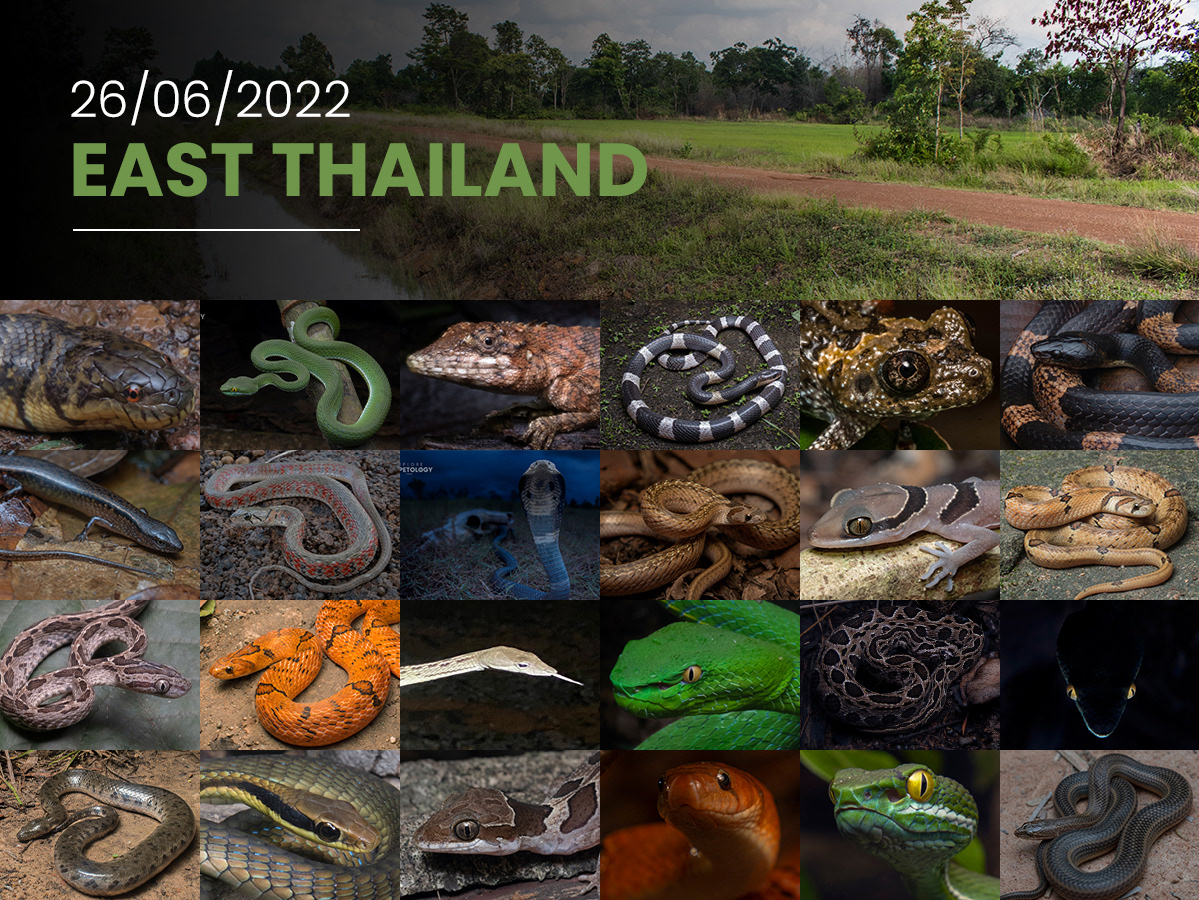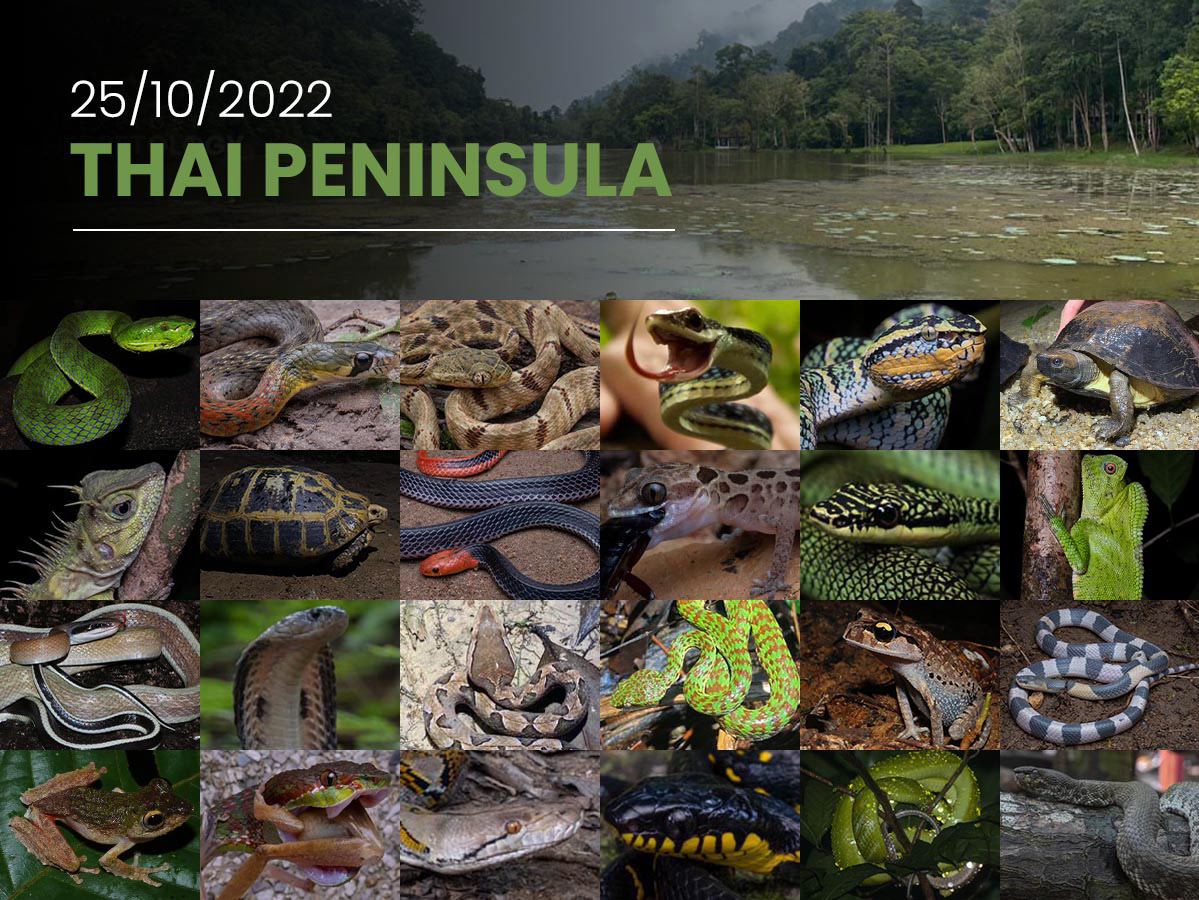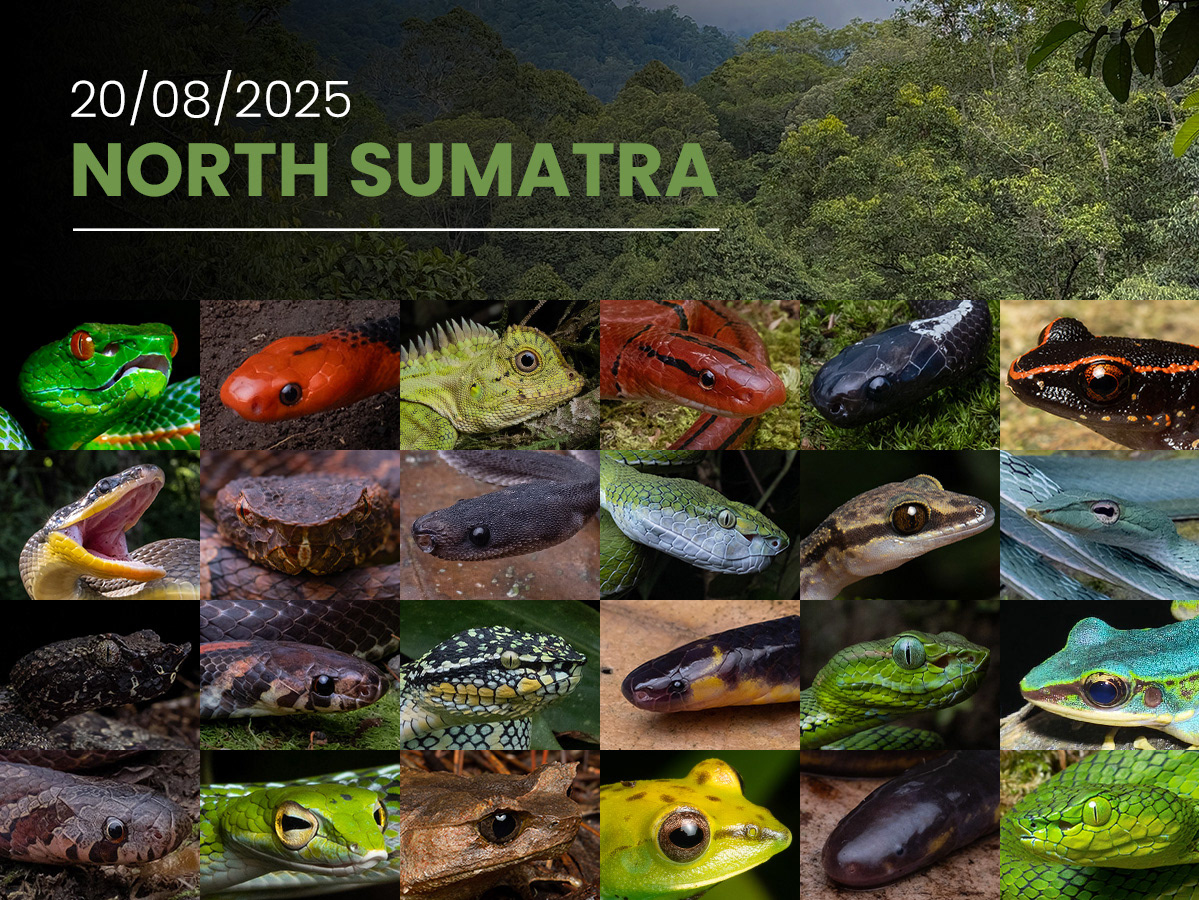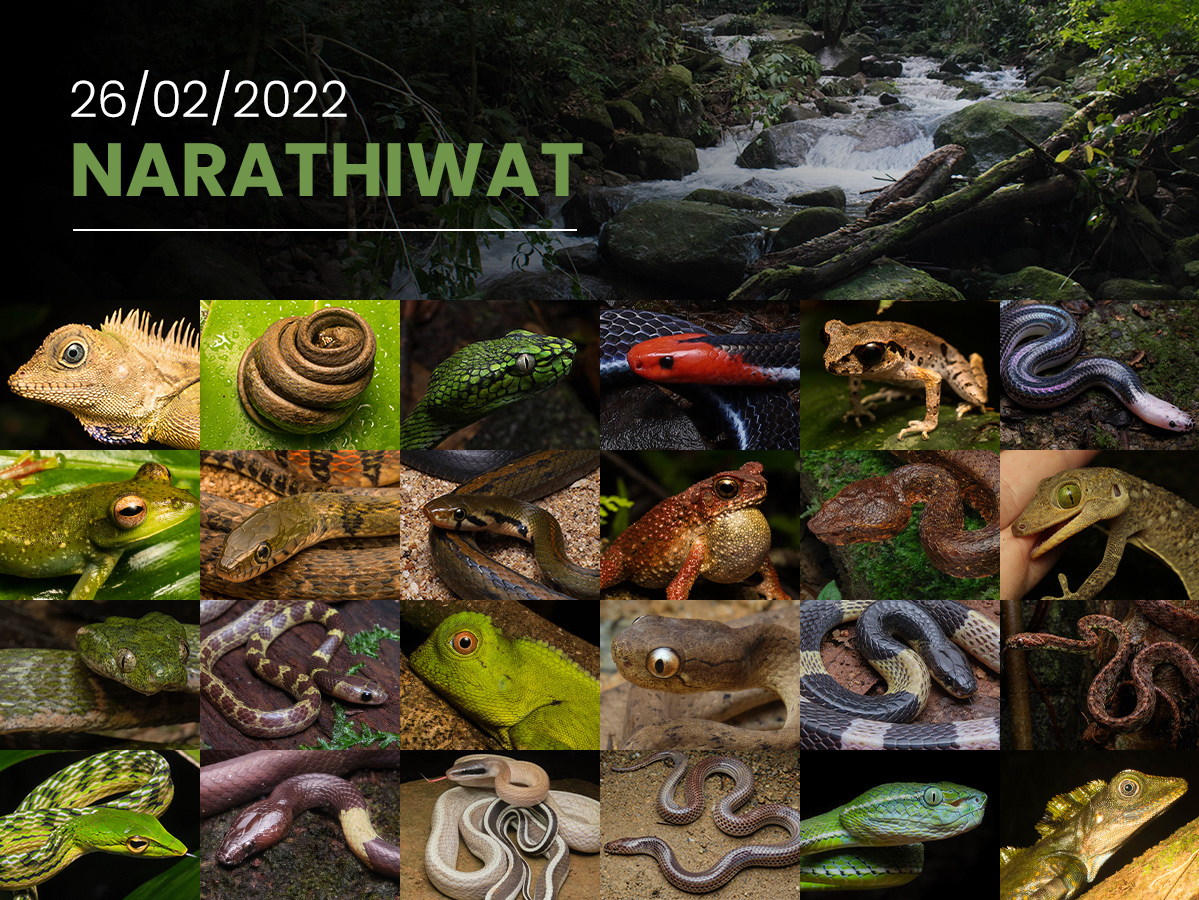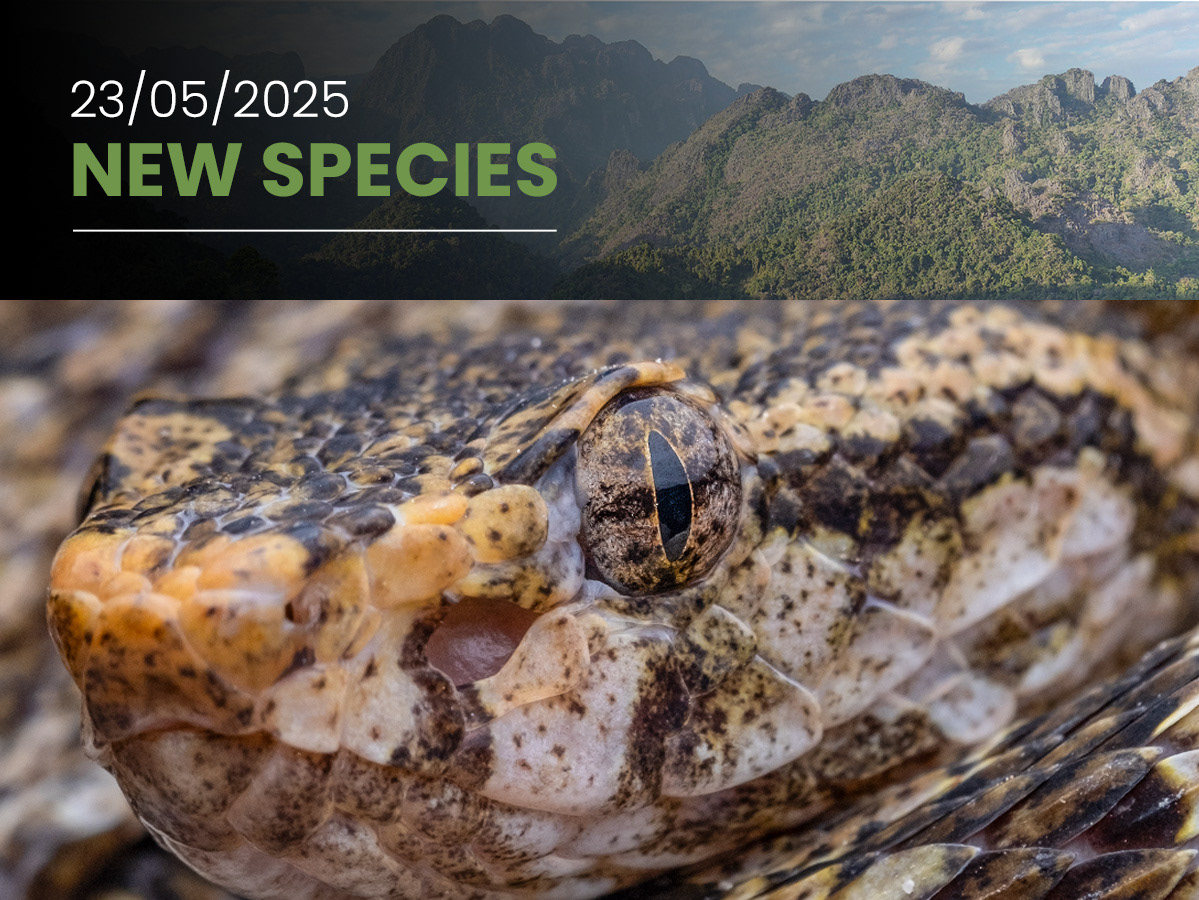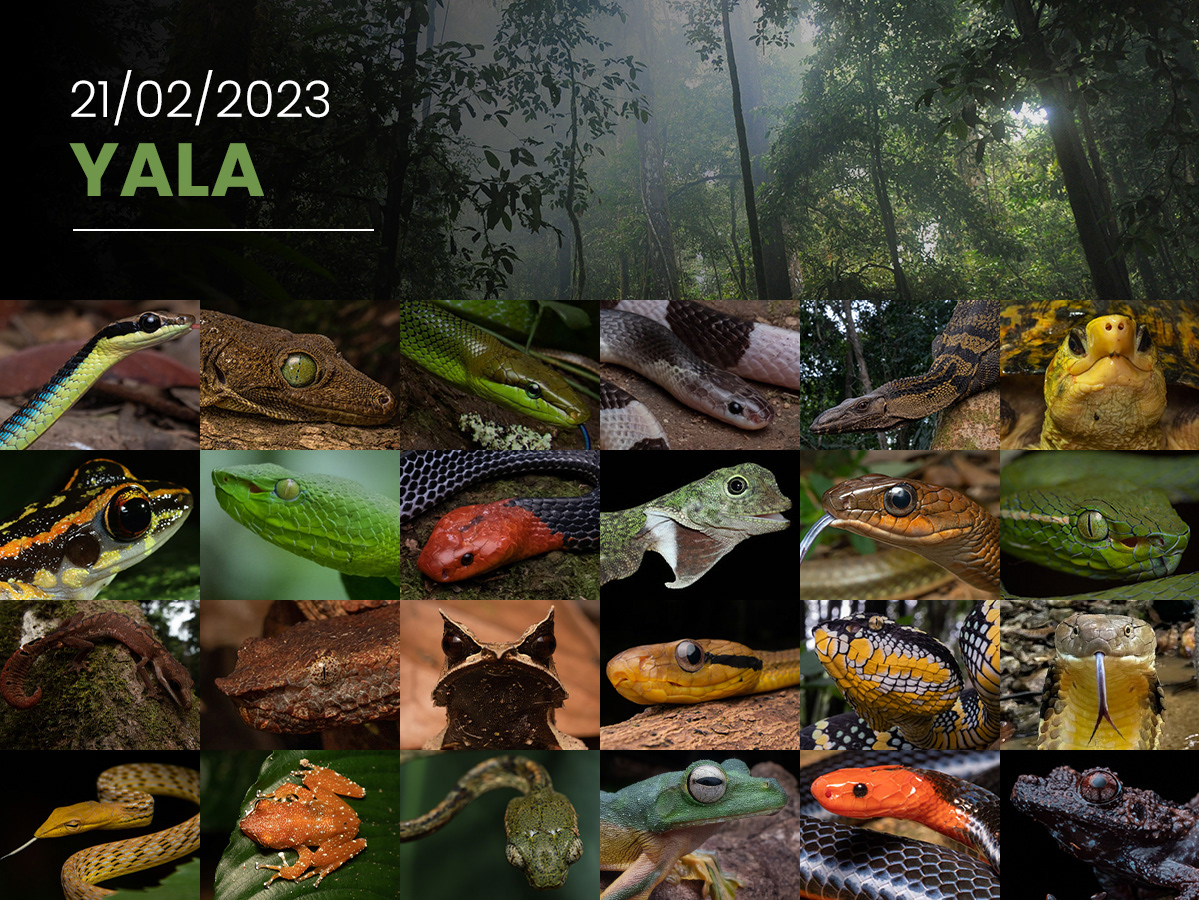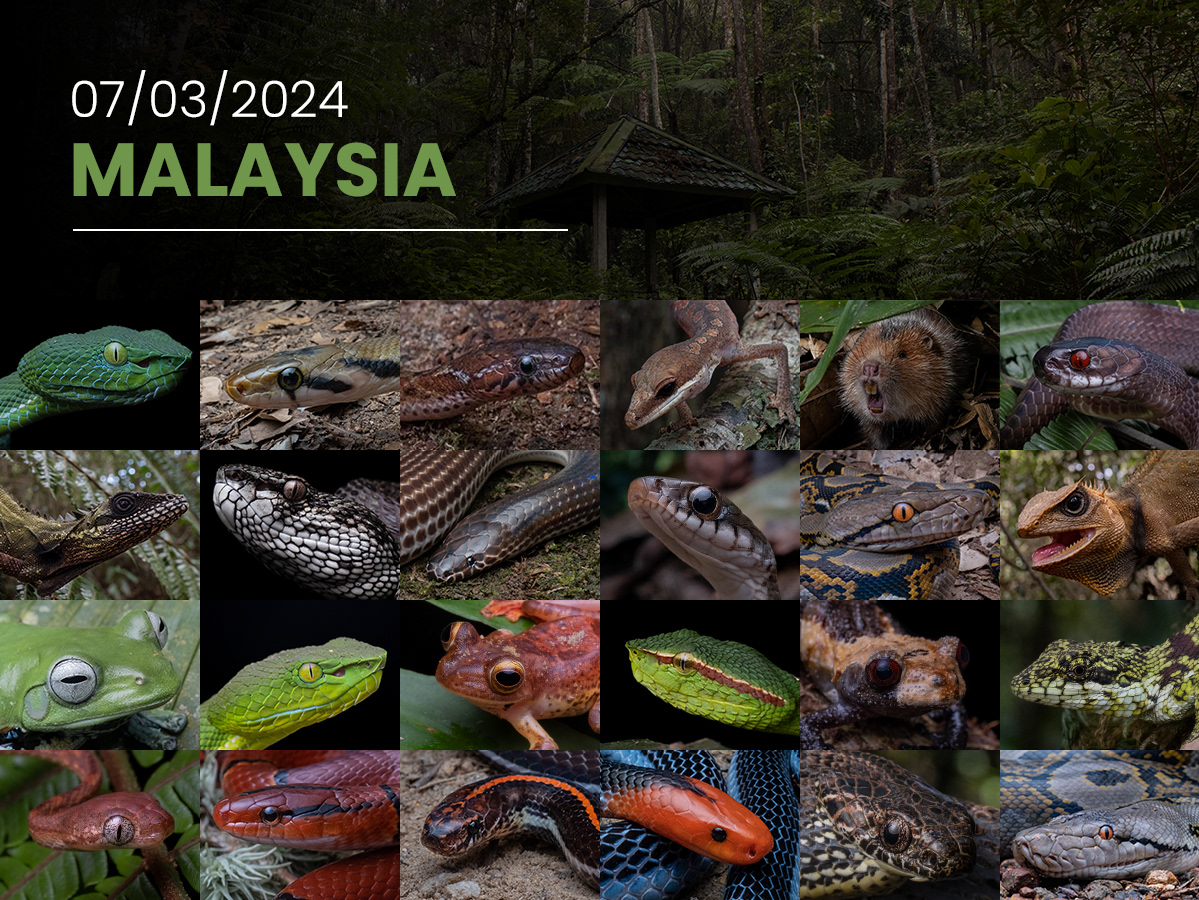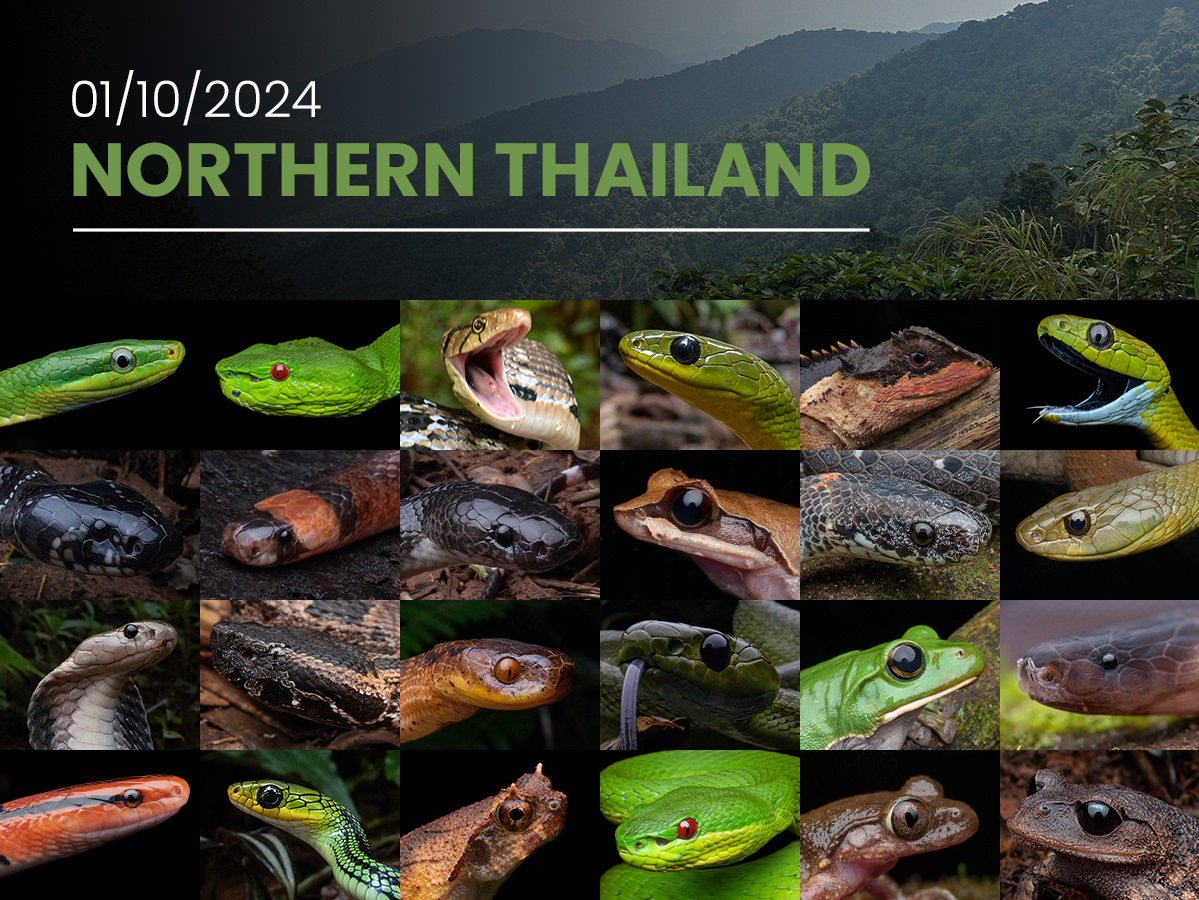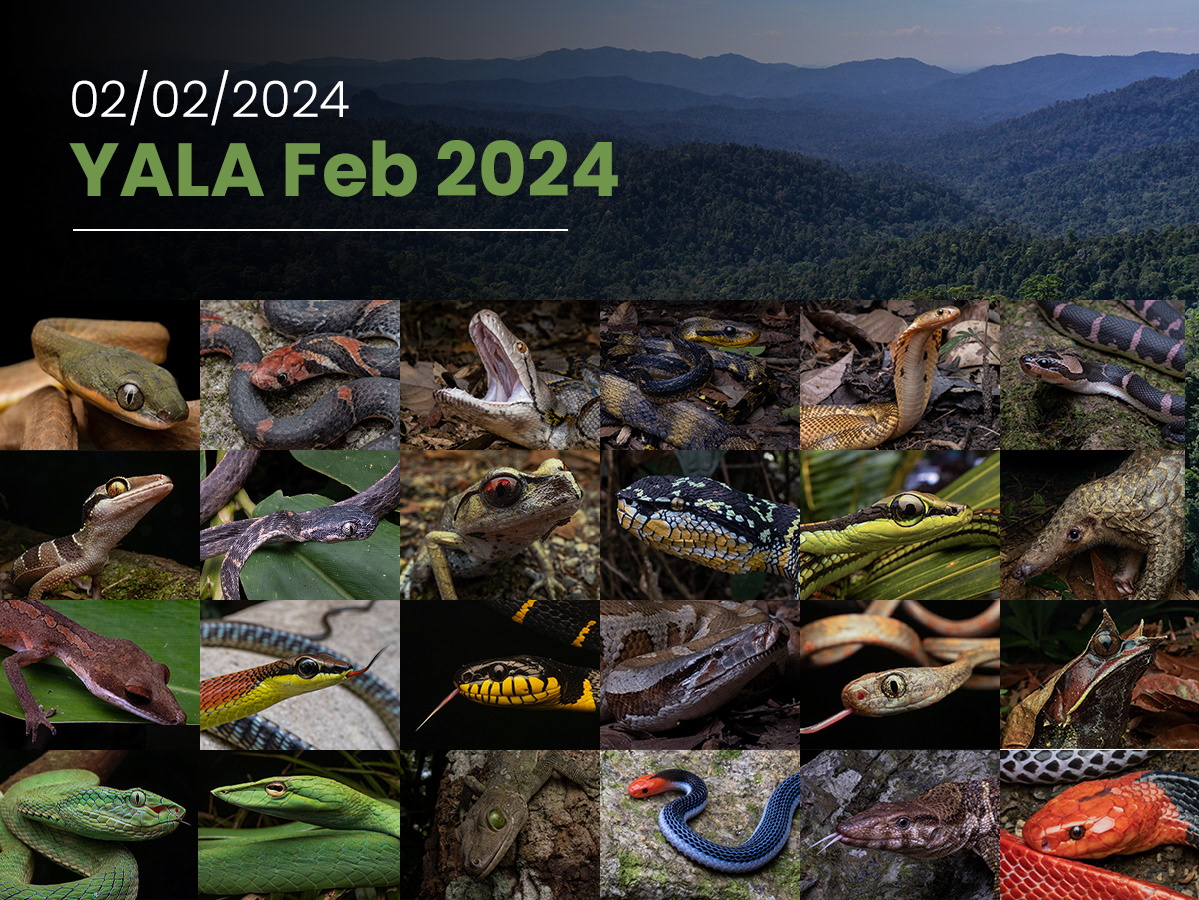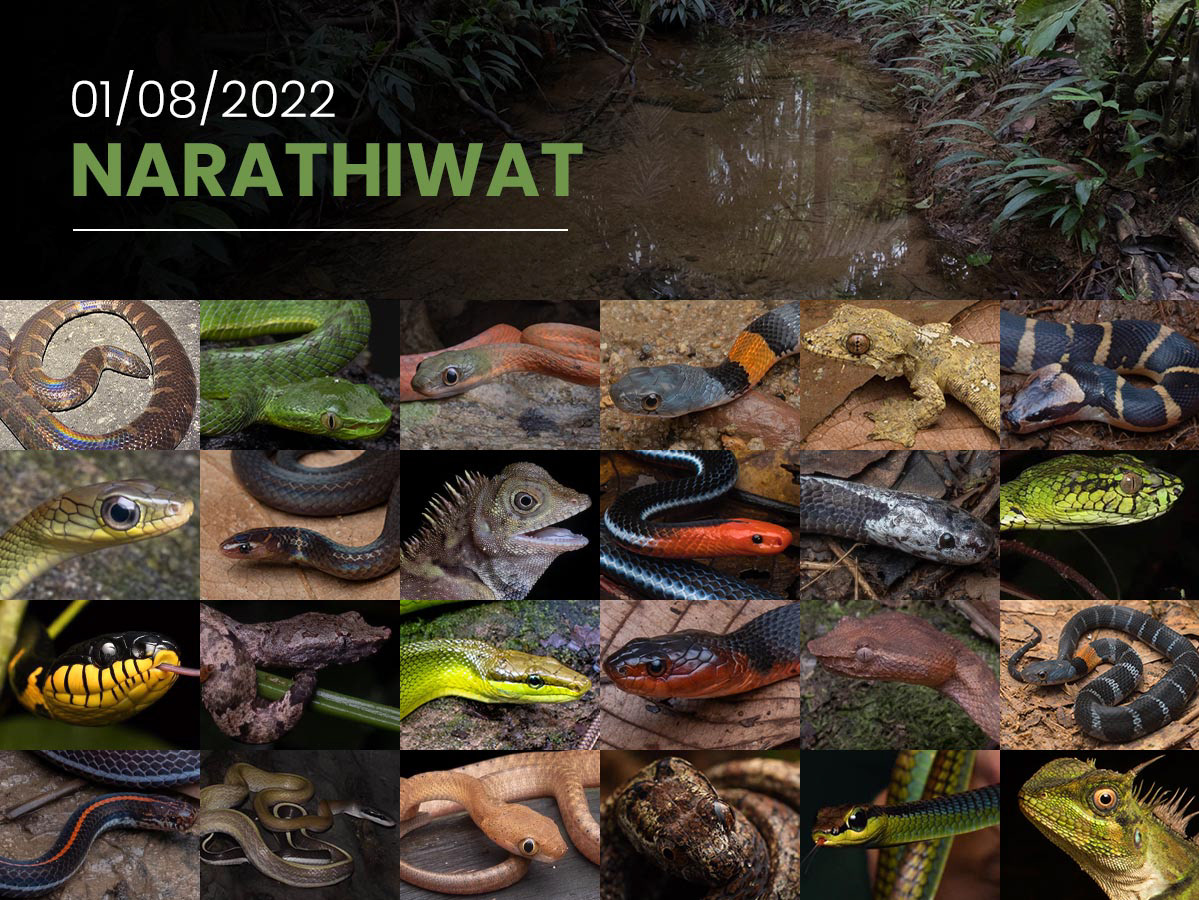Introduction
Unlike our typical trip reports, this will not be a day-by-day account of one herping expedition. Instead, we will look at some of the greatest moments and biggest highlights from our recent 3 group expeditions to Sabah, in North-Western Borneo. The first of these expeditions took place between the 2nd - 12th December, with another from the 17th - 26th February and most recently from the 20th - 28th March. Every expedition was packed with incredible moments and unique finds - as to be expected in one of the most biodiverse areas in the planet - and we will revisit some of those across this report.
This report will feature the finds in a sort of chronological order, fitting the typical structure of our expeditions - with 4 nights in the highlands of Mount Kinabalu, followed by 5 nights in the lowlands of Poring. We will therefore miss many amazing moments and encounters, but it keeps well to the traditional format of our trip reports, with day-by-day recounting of events.
Mount Kinabalu (Days 1 - 4)
The first location we visit during our Borneo expeditions is the highlands of Mount Kinabalu, near Kundasang. The main targets here are always the famous montane 'showstopper' snakes, such as Malcolm's pit viper (Trimeresurus malcolmi), Chasen's mountain pit viper (Garthius chaseni) and several other remarkable endemics. This cool-weather environment is also home to a broad selection of other unique endemic herpetofauna, significantly rarer than some of the snakes.
Day 1: Highland Dragon
While most of our search effort is concentrated at night (for maximum results), when the weather permits we always try to search for wildlife in the daytime as well. A break in the rain during our first day of the December expedition provided an opportunity to go hiking in the daytime, and a spike of UV provided the opportunity to find basking reptiles. Sure enough, while searching the banks on the side of the road, we spotted a medium sized lizard abruptly move as we got close. Fortunately, it did not escape and we got hands on for the first time with the legendary Kinabalu crested lizard (Hypsicalotes kinabaluensis). This species is endemic to the highlands of the Crocker Range and no easy feat to find, let alone catch. This adult male was a perfect example, marking probably the most memorable daytime encounter we ever had in the highlands.

The peaks Mount Kinabalu half-shrouded in cloud.
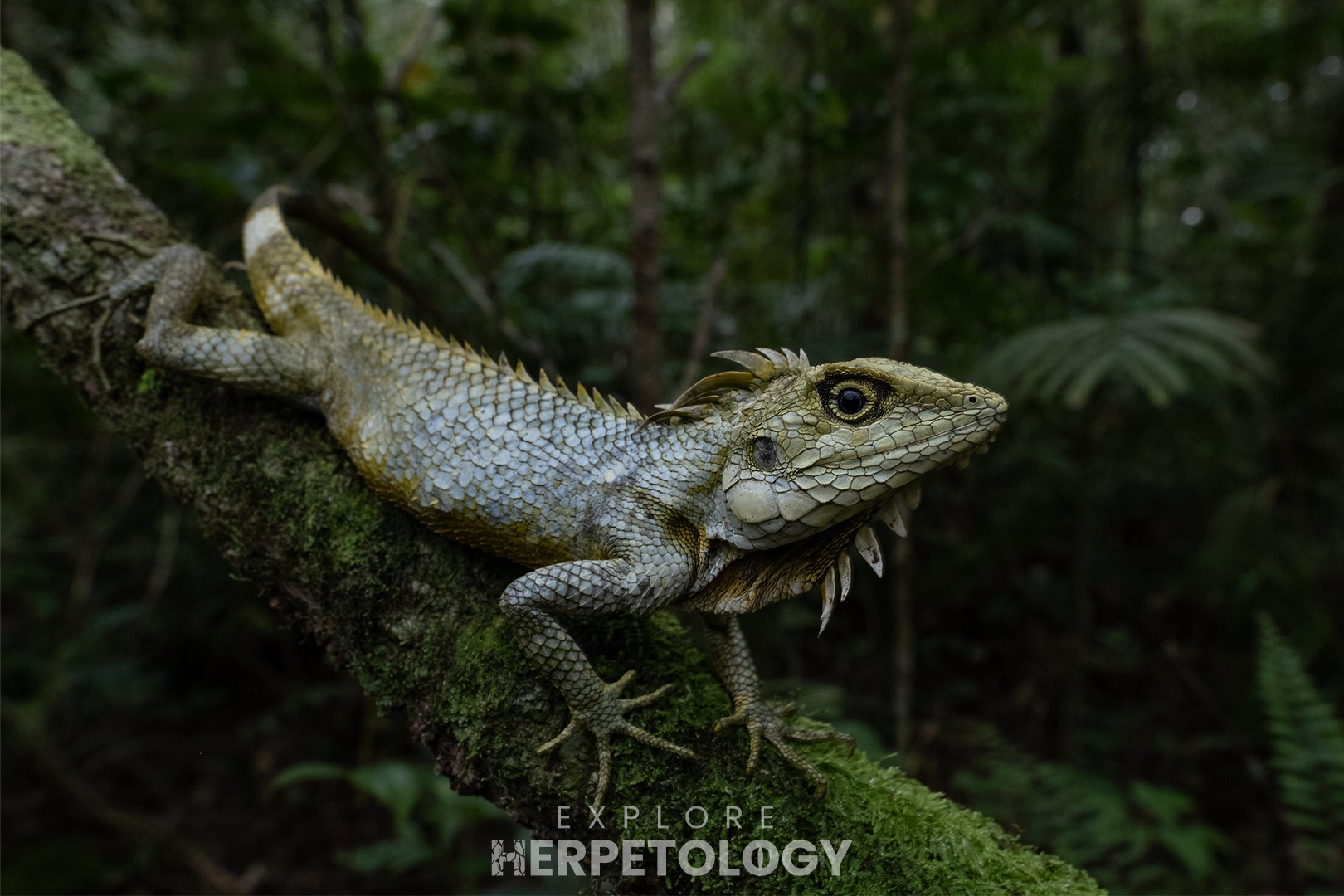
Kinabalu crested lizard (Hypsicalotes kinabaluensis)
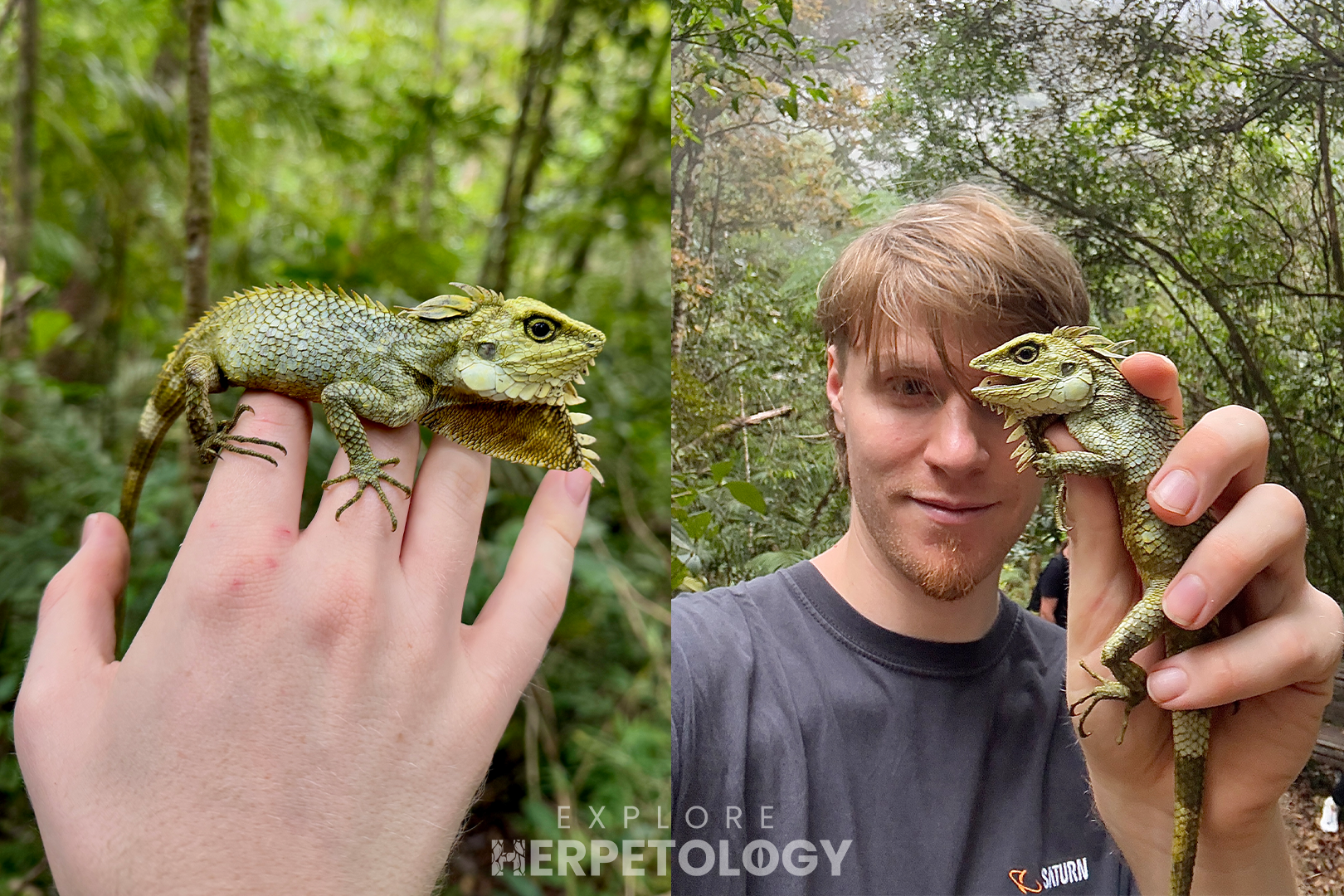
Kinabalu crested lizard (Hypsicalotes kinabaluensis)
Day 2: Caramel and Chocolate
As mentioned previously, one of our biggest targets when visiting the area is Chasen's mountain pit viper (Garthius chaseni), a highly secretive, ground-dwelling crotalid similar in appearance and ecology to the Ovophis sp. elsewhere in South-East Asia. This monotypic genus is restricted to the highlands of Borneo, and almost impossible to encounter without rain. Extremely heavy rain or prolonged periods of light rain force this species out of hiding (within burrows and deep within leaf litter) and to search for dry ground, which is the best time to search for them.
We have been lucky with heavy rains during most nights in the highlands over this winter season and, over time, had improved our ability to target them, leading to encounters on every expedition. The best encounter occurred on the February expedition, where we decided to try road cruising late at night for this species after a fruitless few hours hiking in the national park. We had both our vehicles together, and seconds after reaching our location the car in front stopped and people started getting out looking excited. It turned out to be a male Garthius chaseni, which is always an exciting find, but this individual was unlike any other we had seen before, either in pictures or in life - vibrant orange and fantastically contrasted against the wet road.
Later, we found a second individual, which was the darkest Garthius we had ever seen. The complete opposite of the orange one encountered previously. Putting them together showed the underrated polymorphism of this cryptic species. We have seen many individuals across our trips but these two have gone down in legend as the two GOAT Garthius, and which one is "better" is still debated to this day. Included below is also an image of a typical individual for reference:
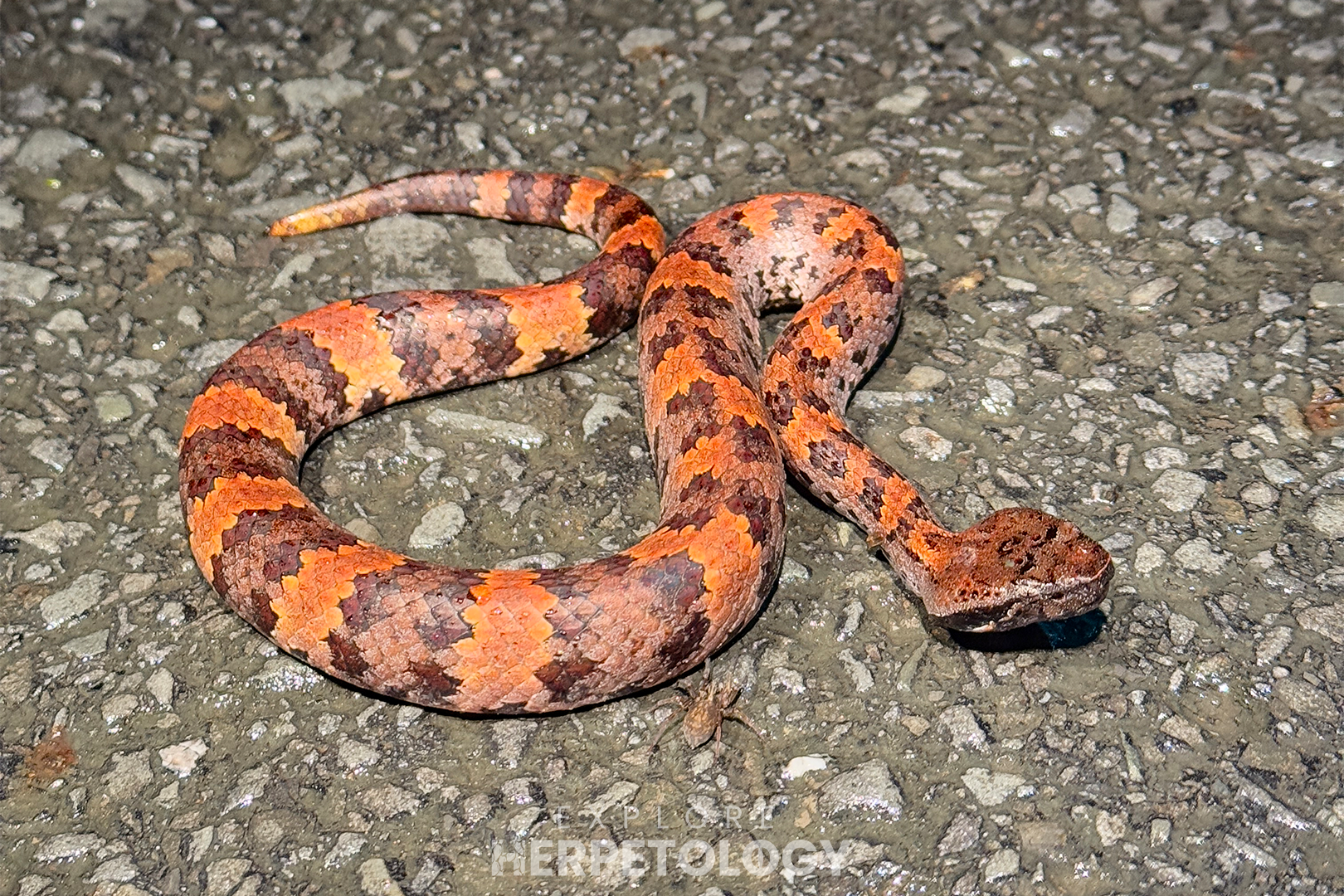
Orange Garthius chaseni.

Dark Garthius chaseni.
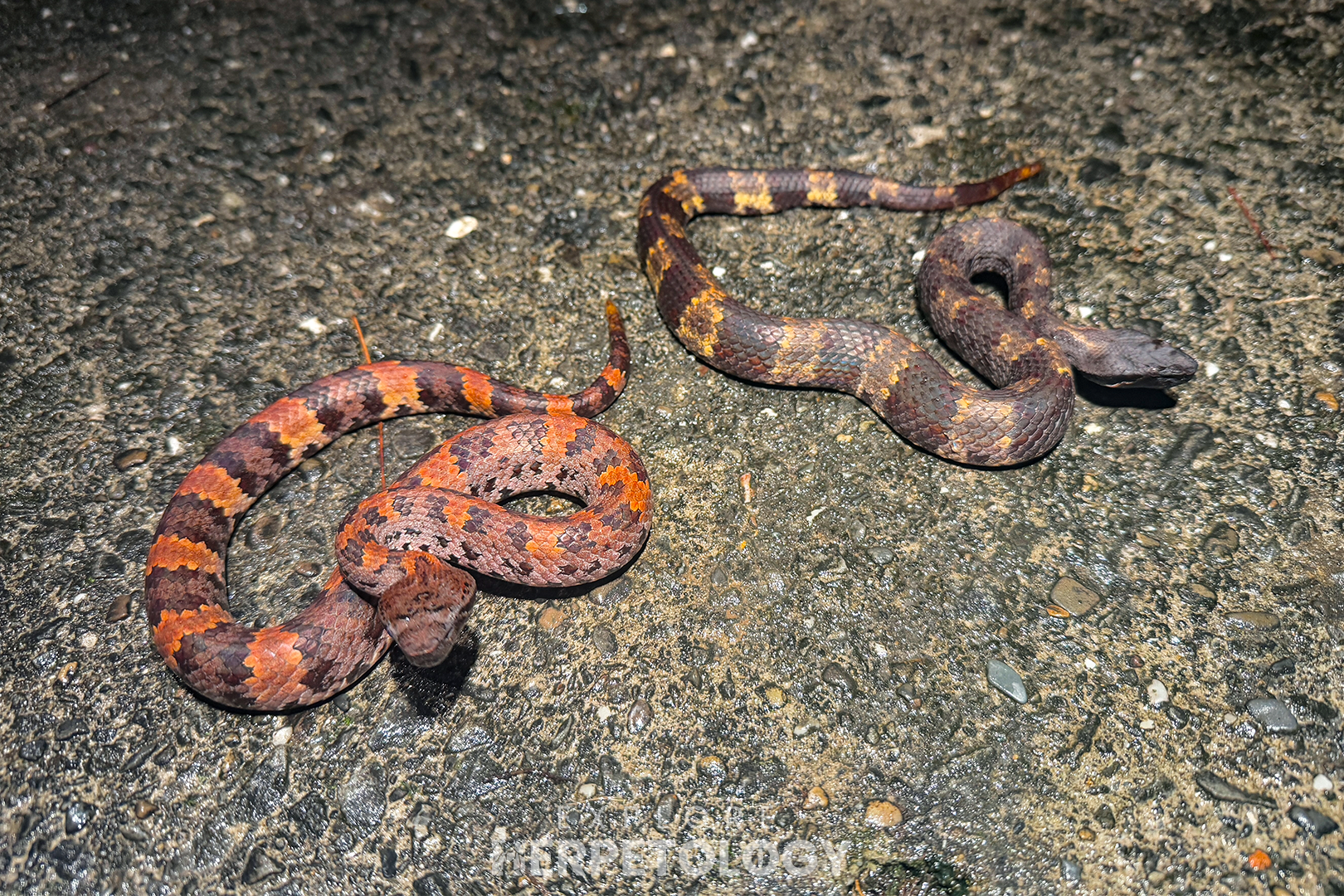
Both together.
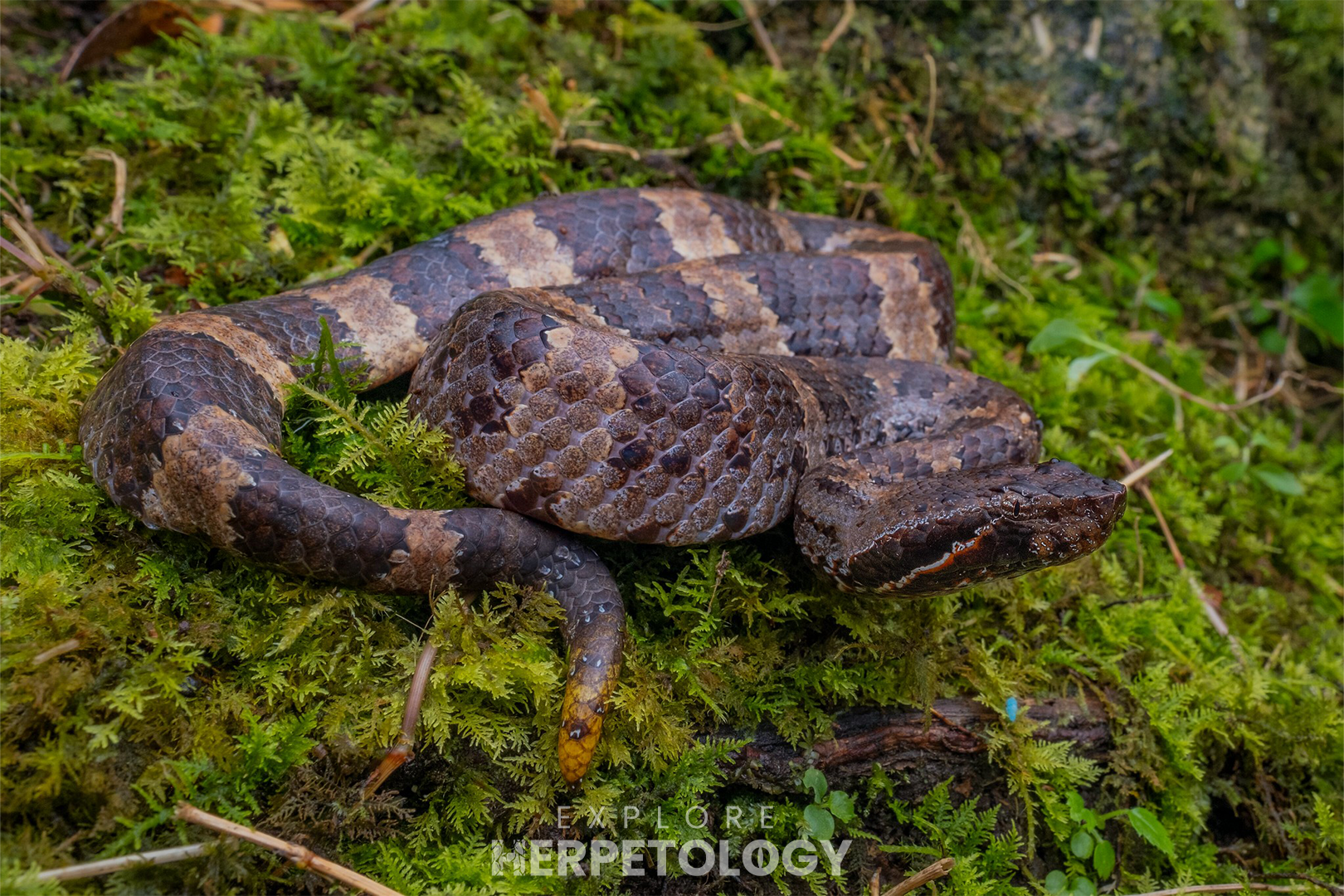
Normal Garthius chaseni.
Day 3: Double Malcolm's
The next magical moment occurred on the same expedition, just one day later. While we had been successful with Garthius chaseni already, we had spent 2 nights relentlessly searching for most people's number 1 montane target, Malcolm's pit viper (Trimeresurus malcolmi), without any luck.
It looked like our third night in the area would go the same way, as it was getting late with not a single Trimeresurus in sight. It was also cold, only 14 degrees celsius at the areas we were hiking. We continued combing the upper elevations on foot, focusing on the areas where we had seen them previously, until finally one was spotted as it slowly crawled on the ground just off the top of a steep slope. This was a moment of elation, as many of our guests had travelled from far away to see this species and were worried we might miss it this time.
Once the snake was secure, Rupert ran up the road to fetch the car in order to bring everyone's camera gear to the snake. Not even 150 meters up, he spotted another large, bright yellowish-green snake and "MALCOLM'S!!!" could be heard echoing across the valleys. Yep, a second, equally massive (~1.2 meter) female Trimeresurus malcolmi was crossing the road just moments after the first encounter. Almost 3 full nights of many hours searching and two show up at once. Typical.
Our team have found an adult Trimeresurus malcolmi on the previous 7 herping tours we have operated to Borneo, not missing it once.
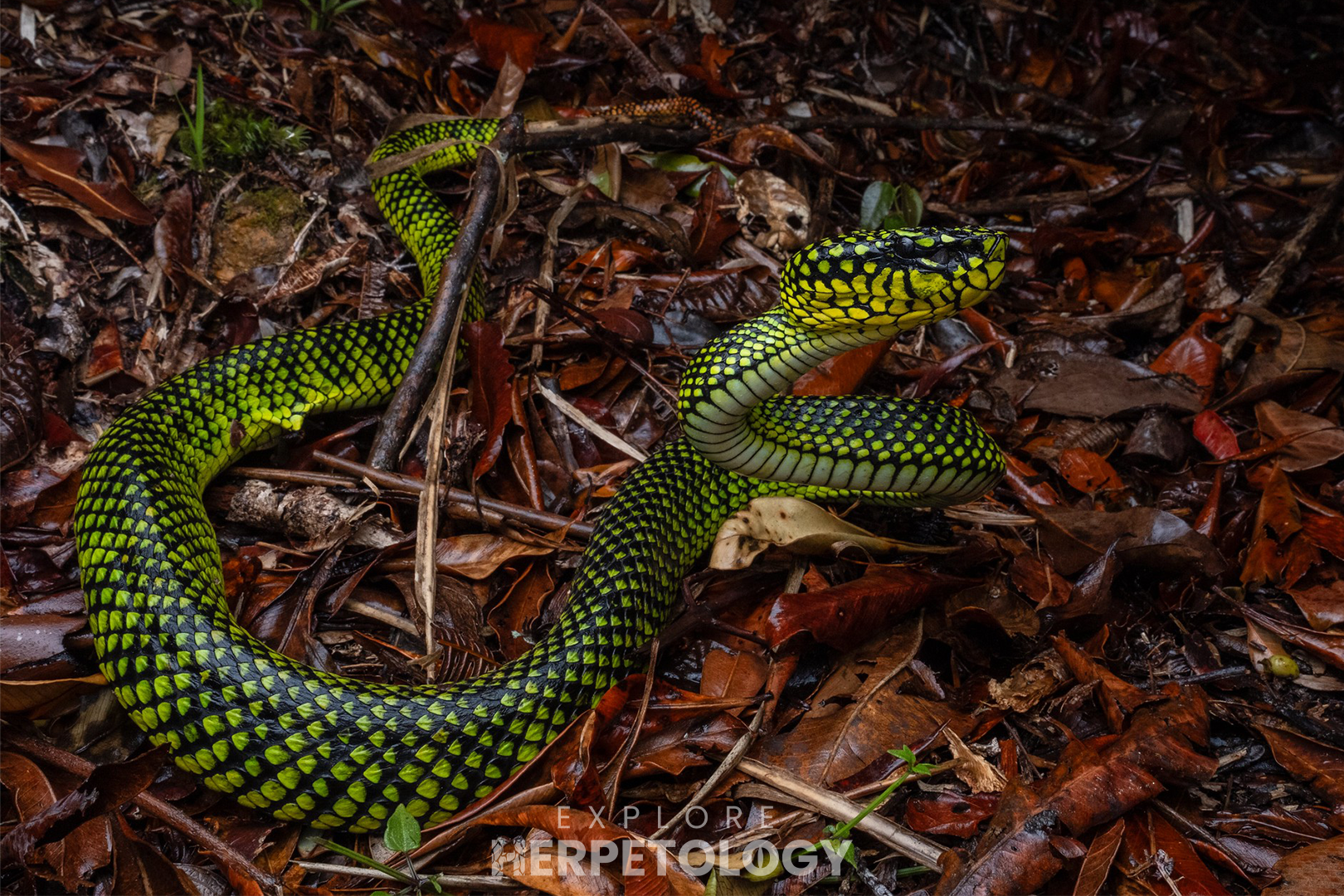
One of the two females.
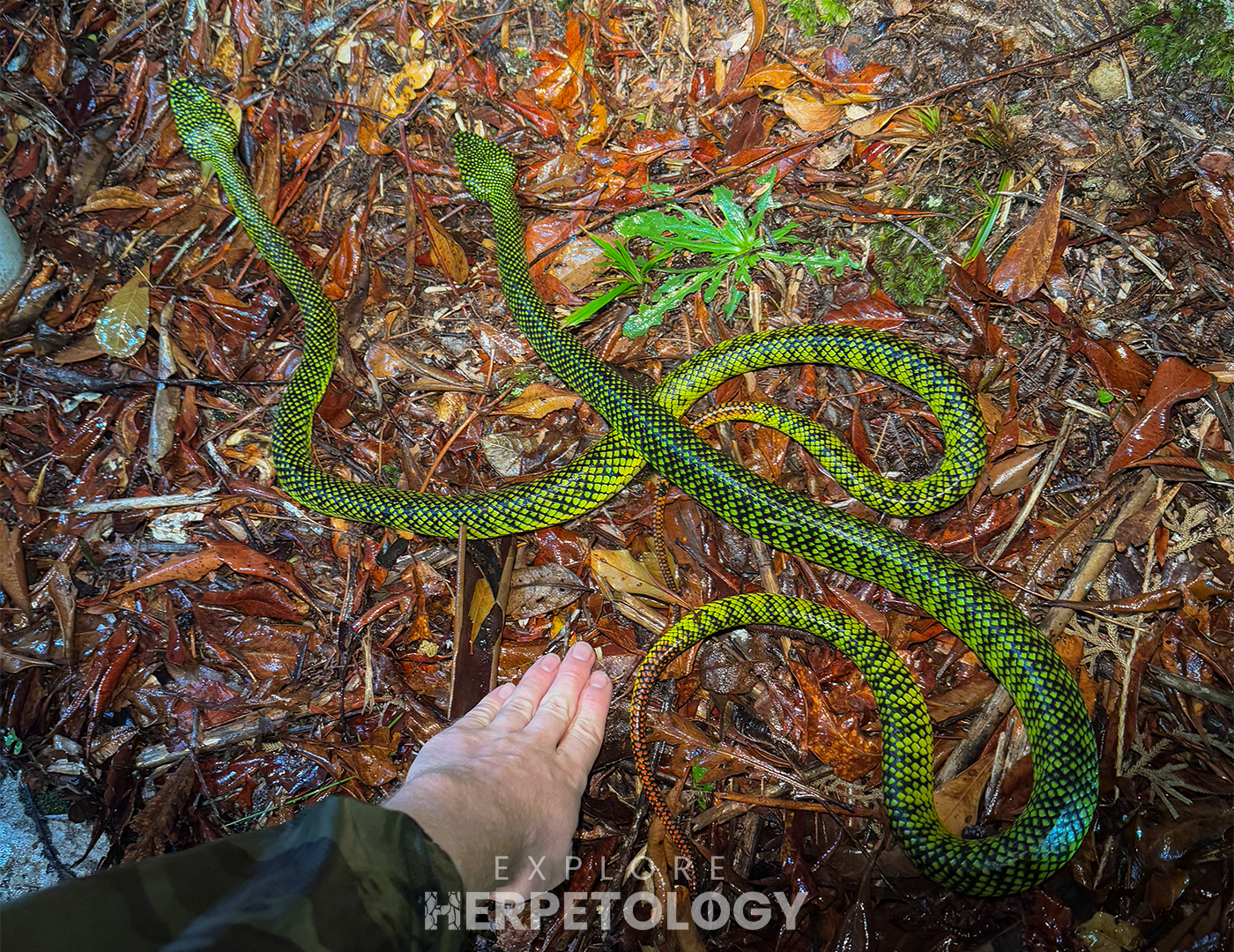
Both together.
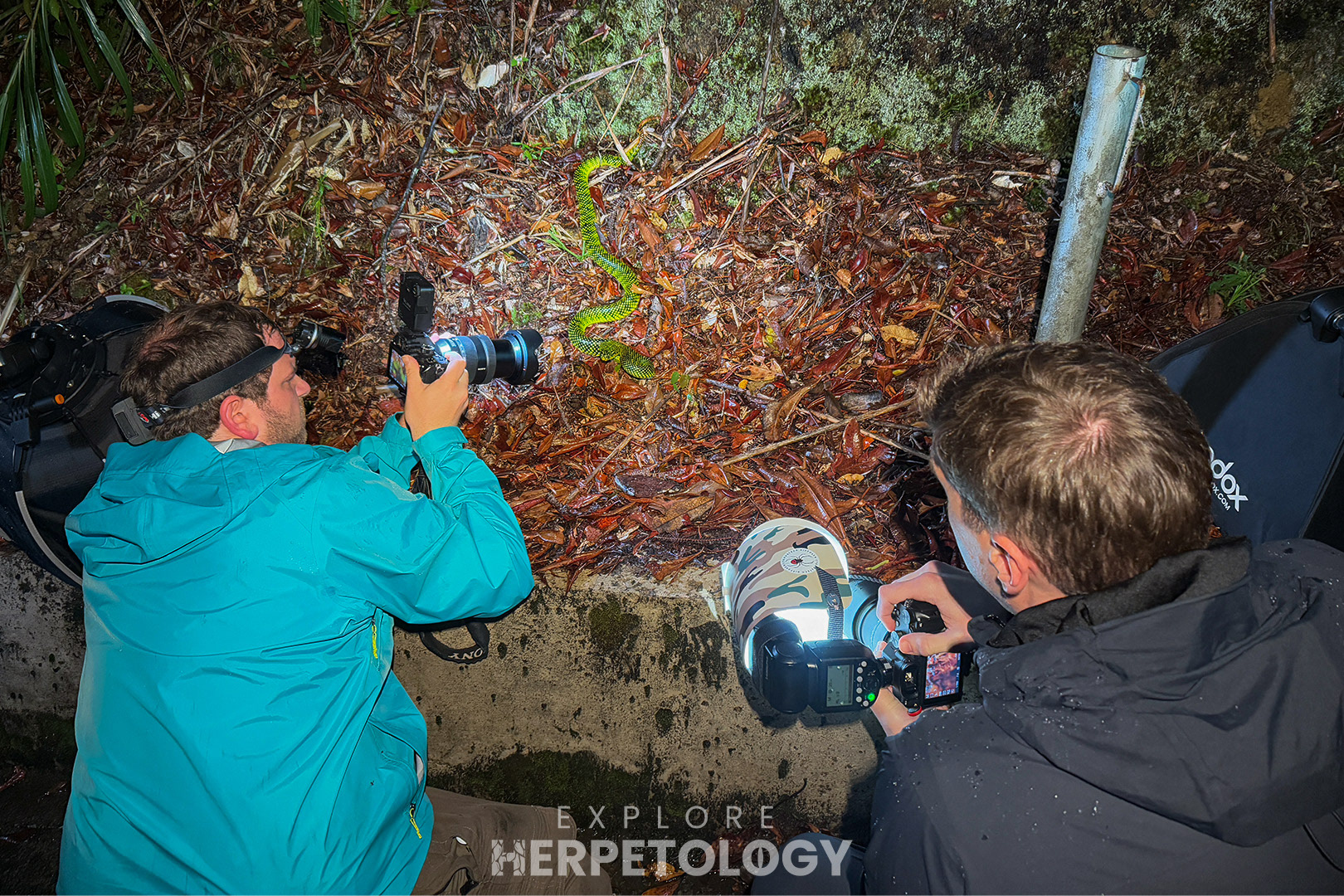
Photography.
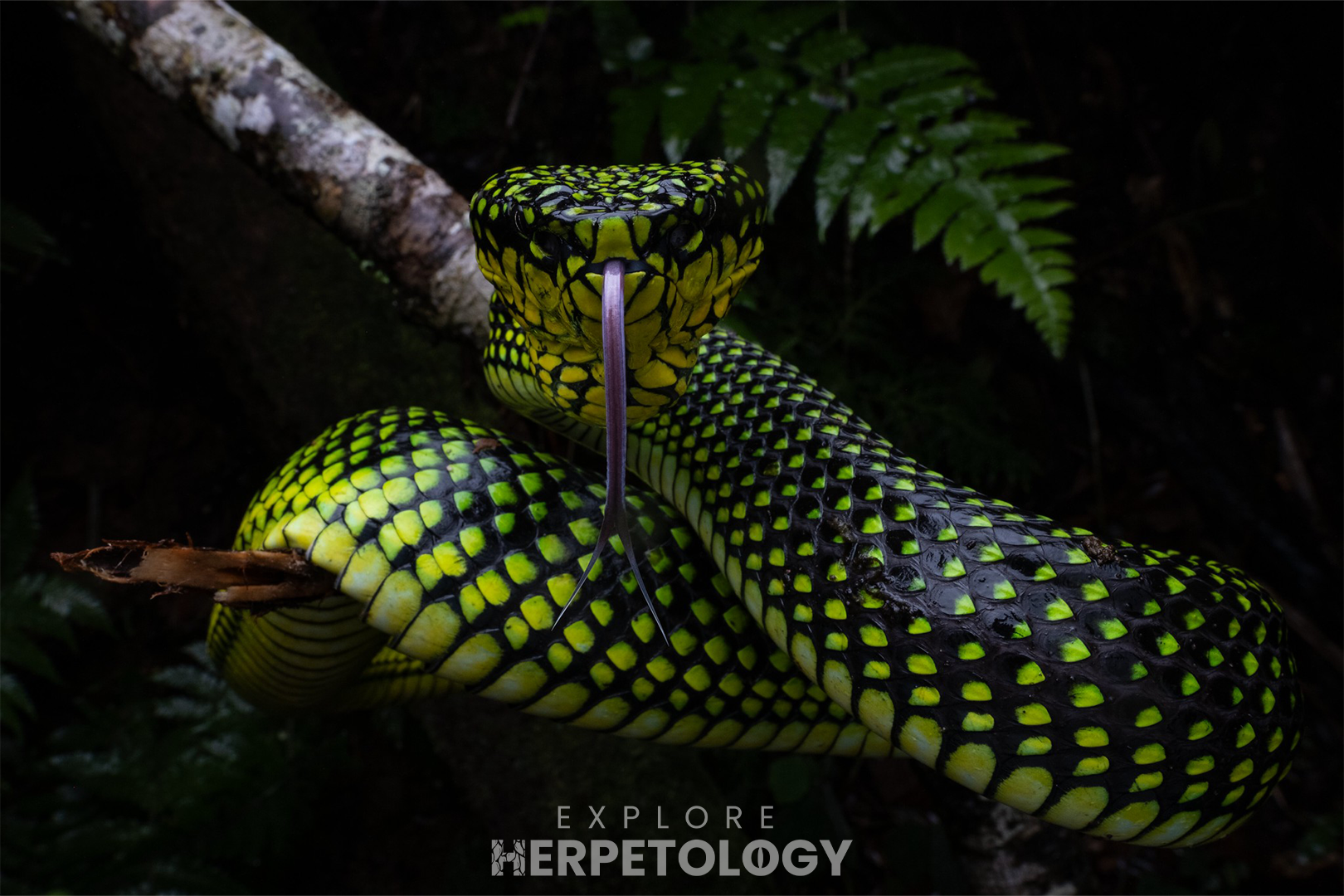
Another large female from March.
Day 4: The Giant
On our fourth and final night in the highlands on the December expedition, we had already found all the highland vipers and were just playing for fun at this point. The night started great, with a beautiful black-striped coral snake (Calliophis nigrotaeniatus) on one of the trails. After this, it started pouring with rain and did not relent for more than 3 hours. We were not able to find anything in this time, unsurprisingly, but once it stopped a dedicated few of us went out to find more Garthius individuals.
The first Garthius we encountered was a nice greyish-blue male, which was road cruised close to where we found the bright orange individual on the February trip. We then hiked some trails, where Yon-Lu found what is currently the size record for the species. An absolute monster female, measuring 76cm - a whole 16cm more than what is recorded in literature. We had seen a few females close to 60cm in the past but this was in a whole different league.

Calliophis nigrotaeniatus
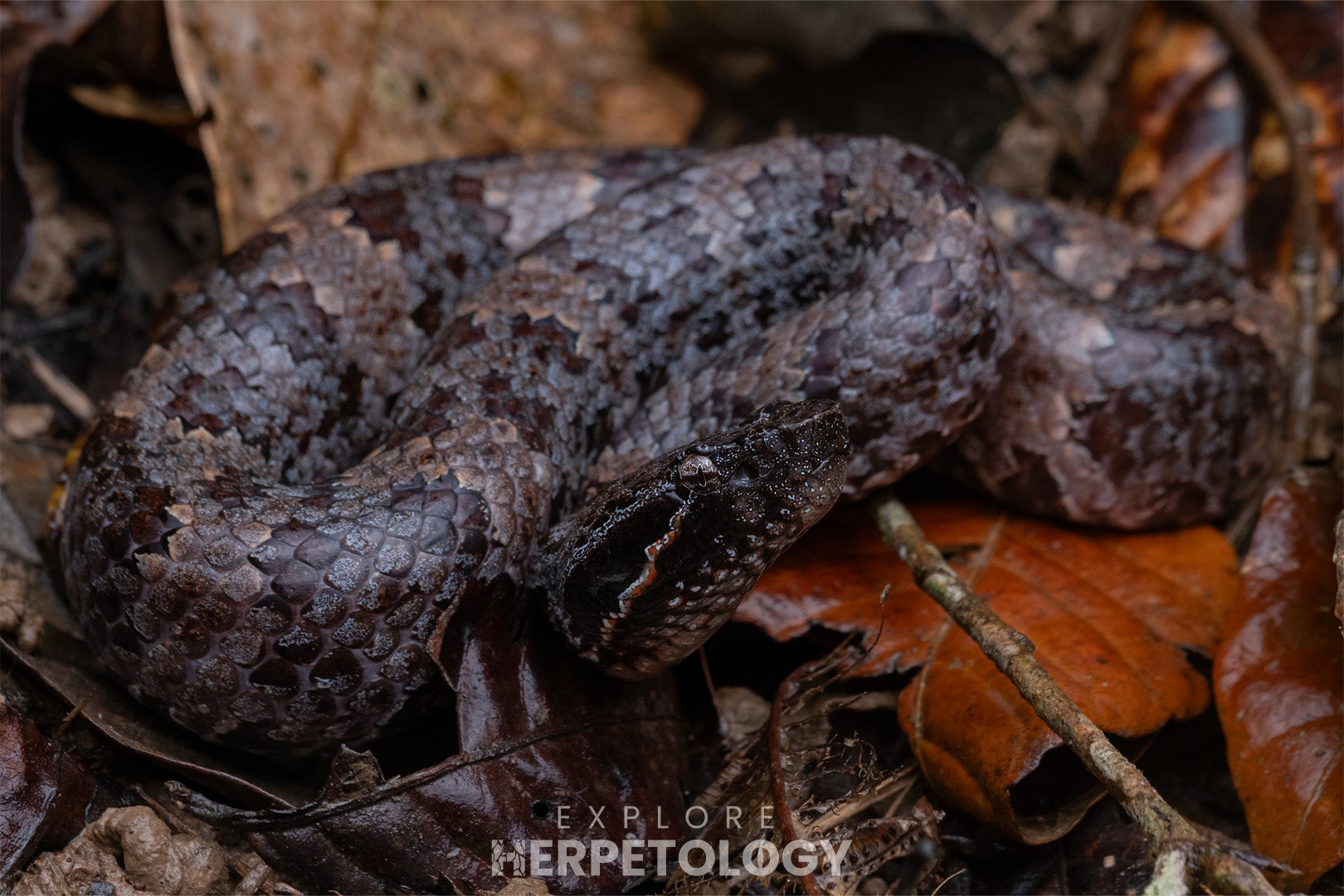
Male Garthius found on the road.

The giant female.
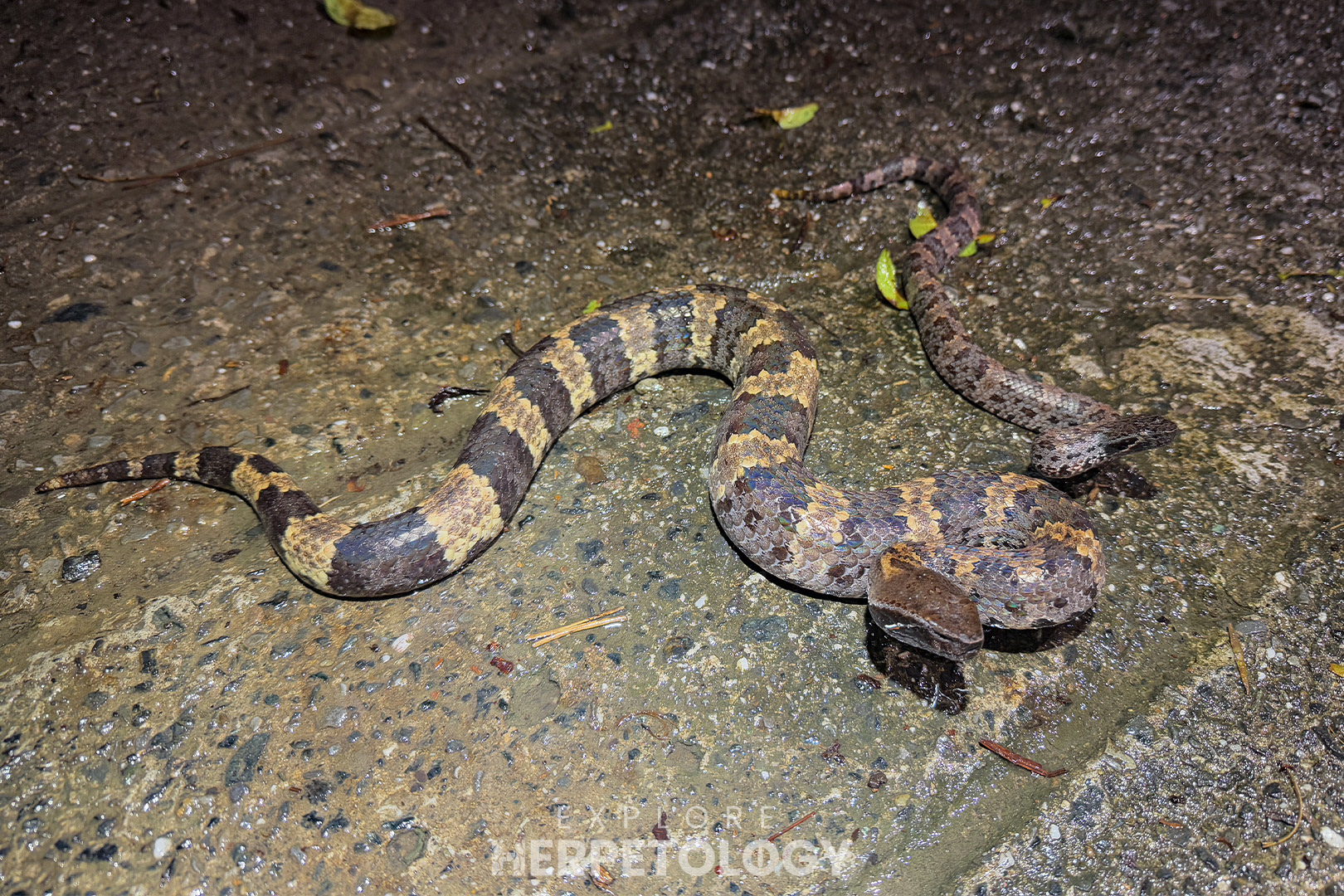
Giant female compared to adult male.
Poring (Days 5 - 9)
After our time in the highlands, we drive down to the village of Poring in the lowlands near Ranau, where we spend 4 to 5 days depending on the length of the specific expedition. The forest here is some of the most biodiverse for herpetofauna of any place in the entire world. The number of species occurring around here is seemingly endless, and we have added several new species of reptile & amphibian on each and every expedition we have ran to the area. We typically alternate between secondary forest trails and the primary rainforest tracks, which offer different species and opportunities on every visit.
Day 5: She Was Shy
On the March expedition, we had found our group's key highland targets on the first night, but the following evenings had been slow for our standards, so we were desperate to hit the lowlands. Very recently, the staff at Lupa Masa rainforest camp had seen an adult female Sumatran pit viper (Trimeresurus sumatranus) in the area and left it undisturbed. While we regularly see Sumatran pit viper at this location, seeing an adult female is an extremely rare occasion and we simply could not let this opportunity slip - especially as they had left it in situ.
Unfortunately, when we hiked to the area of forest where it was last seen, it was gone. We split up and covered as much ground as possible, but she was not found. We continued herping regardless and found several common species, which seemed like they would be all. However, David and our Lupa Masa guide had one last go at the end of the night, where they finally found her coiled deep in some low vegetation not far from where we had been searching earlier. This was our sole encounter with a large female displaying the pale yellow colouration and strong black markings across the winter season (although we saw a much larger one last summer), what an amazing snake.

Sumatran pit viper
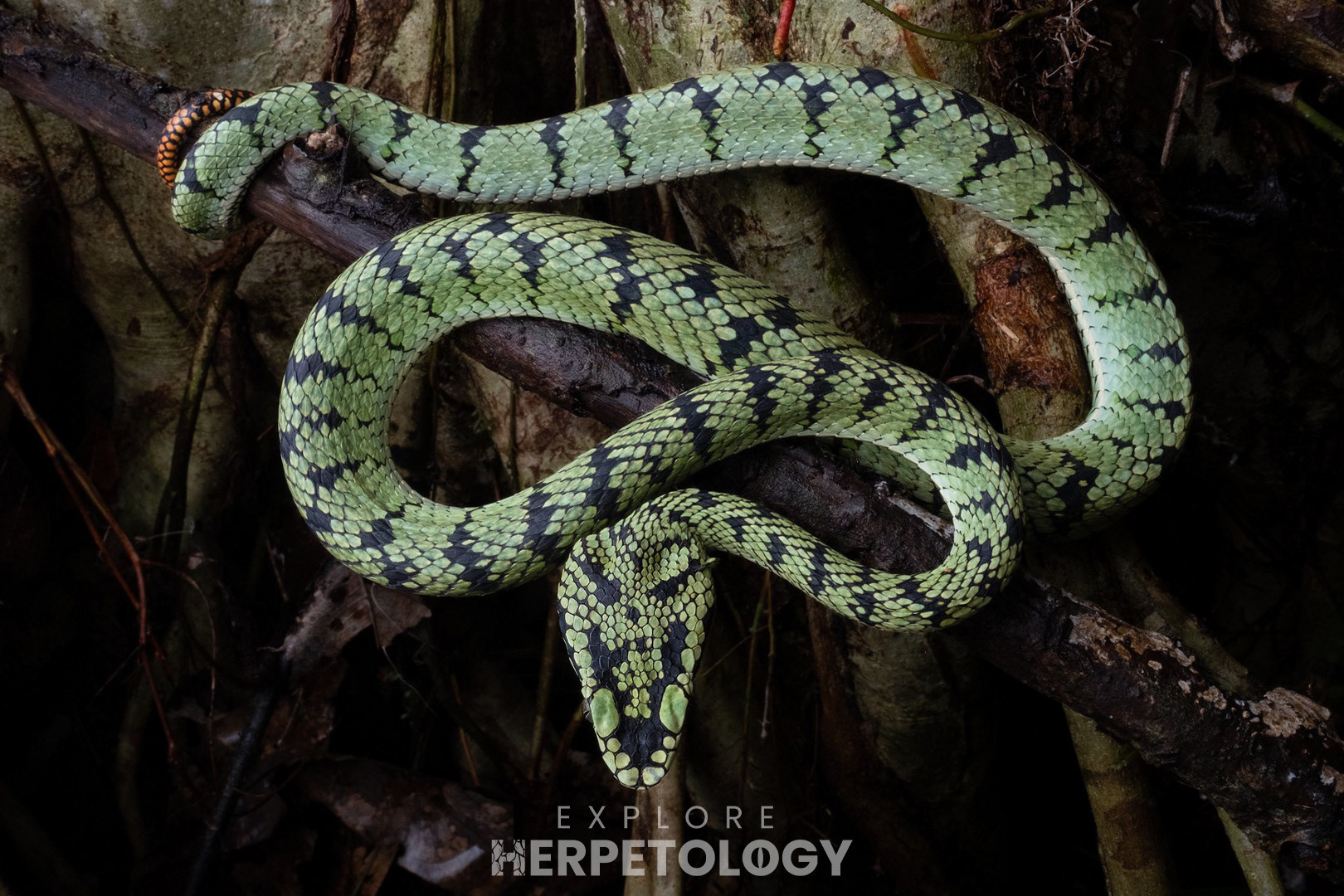
Trimeresurus sumatranus
Day 6: Never Give Up
On the February expedition, most of our group was absolutely desperate to see an adult female Borneo keeled pit viper (Tropidolaemus subannulatus). This species is widespread and common across Borneo, but finding large females isn't always easy - especially in the Poring area. February is also one of the worst times of year to see T. subannulatus females, as they tend to hide high in the canopy while gravid.
We started the second night in the lowlands on this trip with a dedication to turn up this species, but a big walk around the usual hotspots was not successful. Only two adult males were spotted, and they are always abundant compared to females. We had seen a female the night before, albeit 10 meters high in a tree and impossible to reach. Having checked every good spot for these (both the previous night and now), our chances seemed bleak, until a heavy rainstorm suddenly arrived and forced us to take shelter in a jungle rest hut. When the rain slowed a little, Rupert wandered out of the hut out of pure dedication to find something, and didn't make it more than a few meters away before shouting that he had found a female Tropidolaemus subannulatus.
Sure enough, a beautiful blueish adult female was crawling along the ground in the open area near the hut. Surely brought down by the rain, as it is very unusual to see females of this species anywhere near the floor. Not long after, we encountered yet another female - much larger and heavily gravid - which was also low enough in a tree to reach with our snake hook. An incredible turn of events with extreme levels of luck involved, ticking off yet another target on an expedition where we found adults of all 6 viper species in the area!

The encounter.
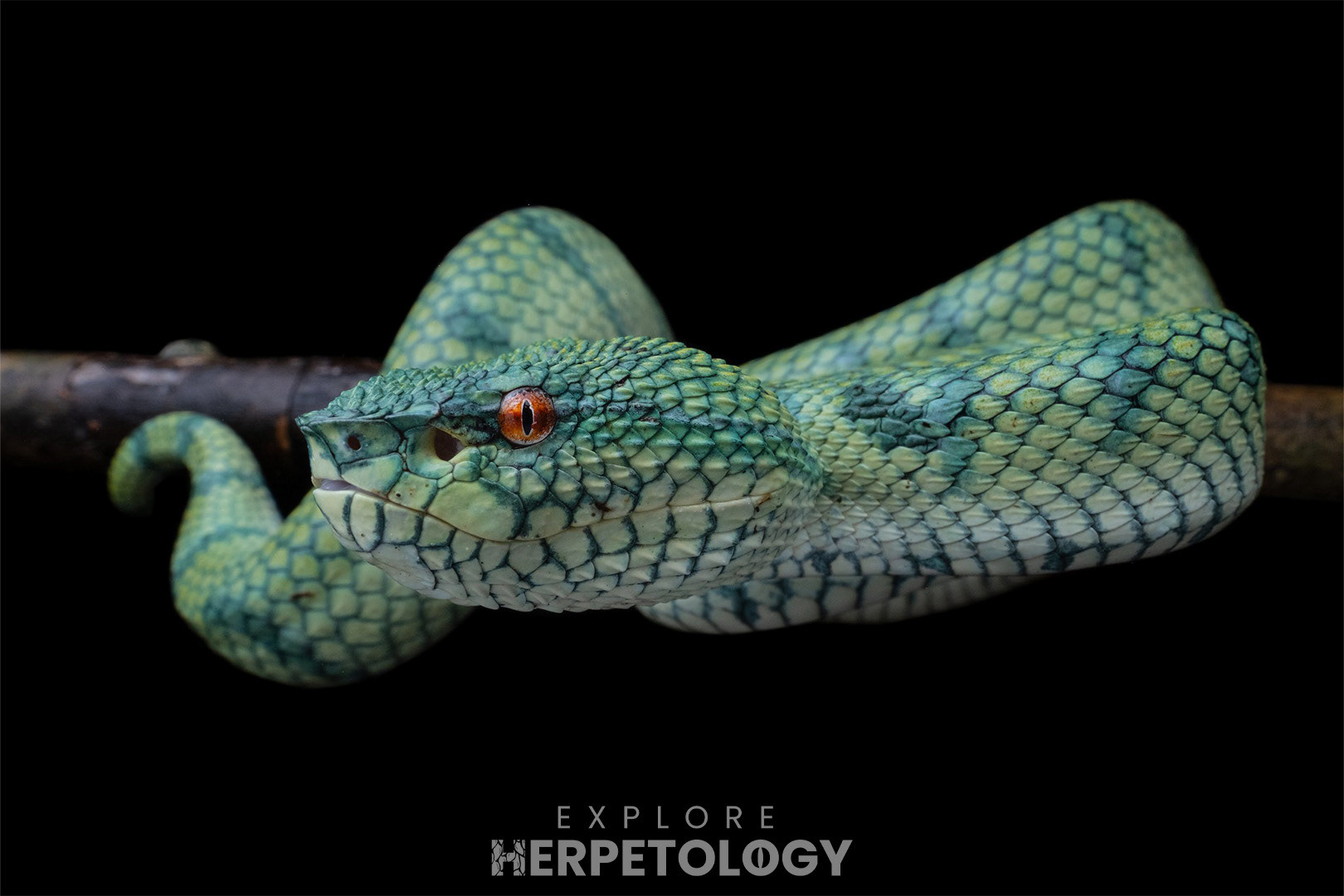
The smaller T. subannulatus.

Huge gravid female.
Day 7: Back to Back
Throughout this streak of expeditions, we had been hoping above all else for an encounter with the legendary Kinabalu krait (Bungarus f. baluensis). This crazy 'subspecies' is endemic to North-West Borneo and is undoubtedly one of the most remarkably patterned snakes in the world. Unfortunately, it has eluded us on both the December and February expeditions.
On the March expedition, we were absolutely dedicated to turn our bad luck (with this species) around and get it. Easier said than done, as it is rare at the best of times, but a DOR individual in the highlands indicated that they were moving. A good sign as this species tends to be active in short, 1 - 2 week bursts where several show up in quick succession. It rained too much in the highlands for us to have a chance on our nights there, and our first two nights in the lowlands showed no sign.
On night 3, we again searched for hours, until half our group had retired to bed. Some of us stayed out late, splitting up into smaller groups to cover more ground. Rupert took some people up a steep hill, while David walked solo along a stream. It was only at the last moments of the hike, while David was getting close to the trail exit, when he spotted a dark snake coiled up in the dense roots of a tree on a muddy embankment. The snake moved once light was shined at it, revealing a bright yellow head. Once it was wrestled out from the roots, we finally had our hands on another Kinabalu krait. This was the last find of the night, of course.
High off this success, we took the following daylight off from herping and got some rest for the evening. Once we attacked the forest, we split into smaller groups and while Rupert was walking just adjacent to the rest of the group near the Lupa Masa campsite, an absolutely unmistakable and unmissable snake crossed the trail in front of him. Yes, another Kinabalu krait, this time a juvenile and ten times more vibrant in colouration than the adult (still with a deep orange head). We went from not seeing this species for multiple expeditions in a row, to finding two individuals back to back. Typical.

Adult Kinabalu krait
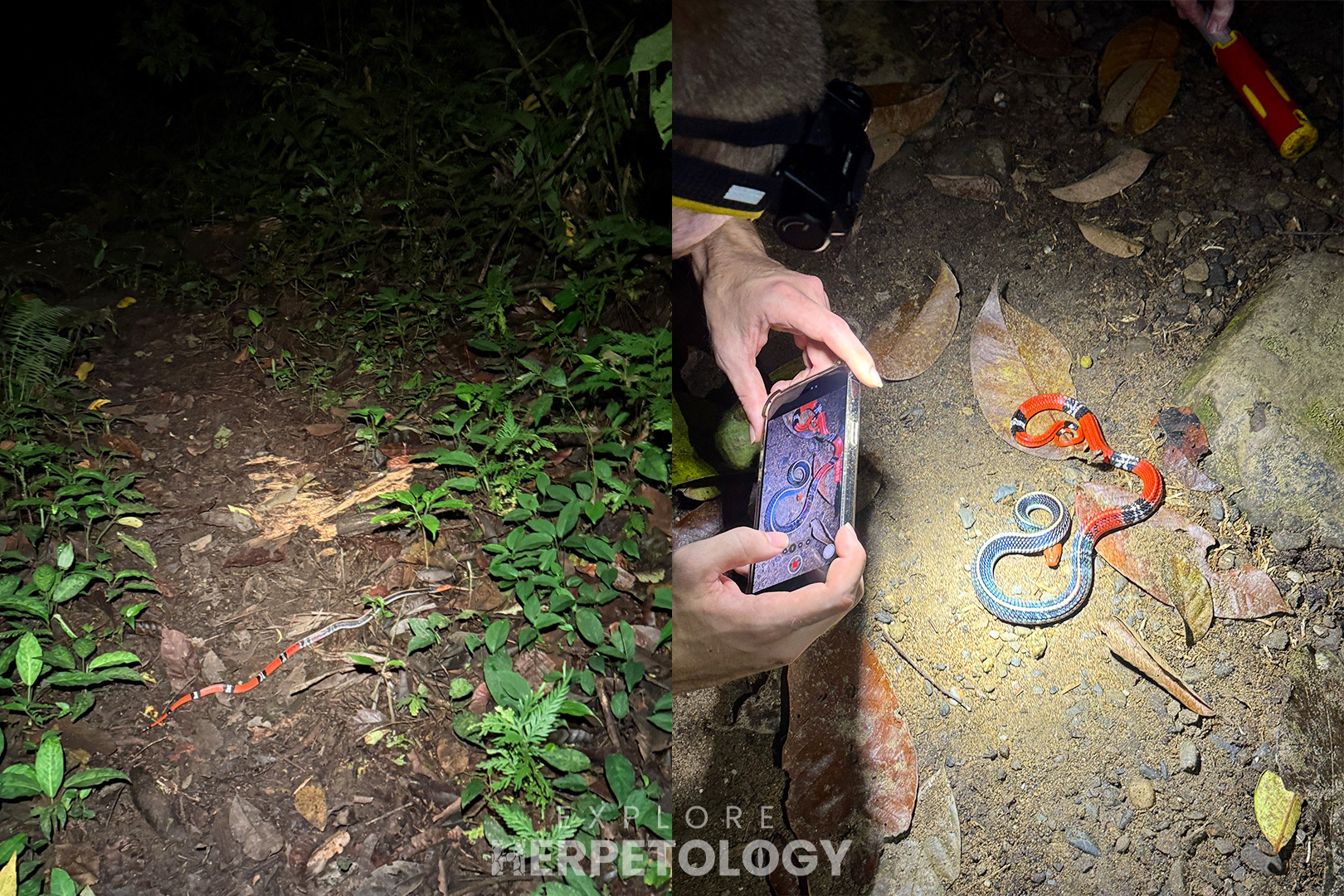
Juvenile in-situ and after capture

Juvenile Kinabalu krait
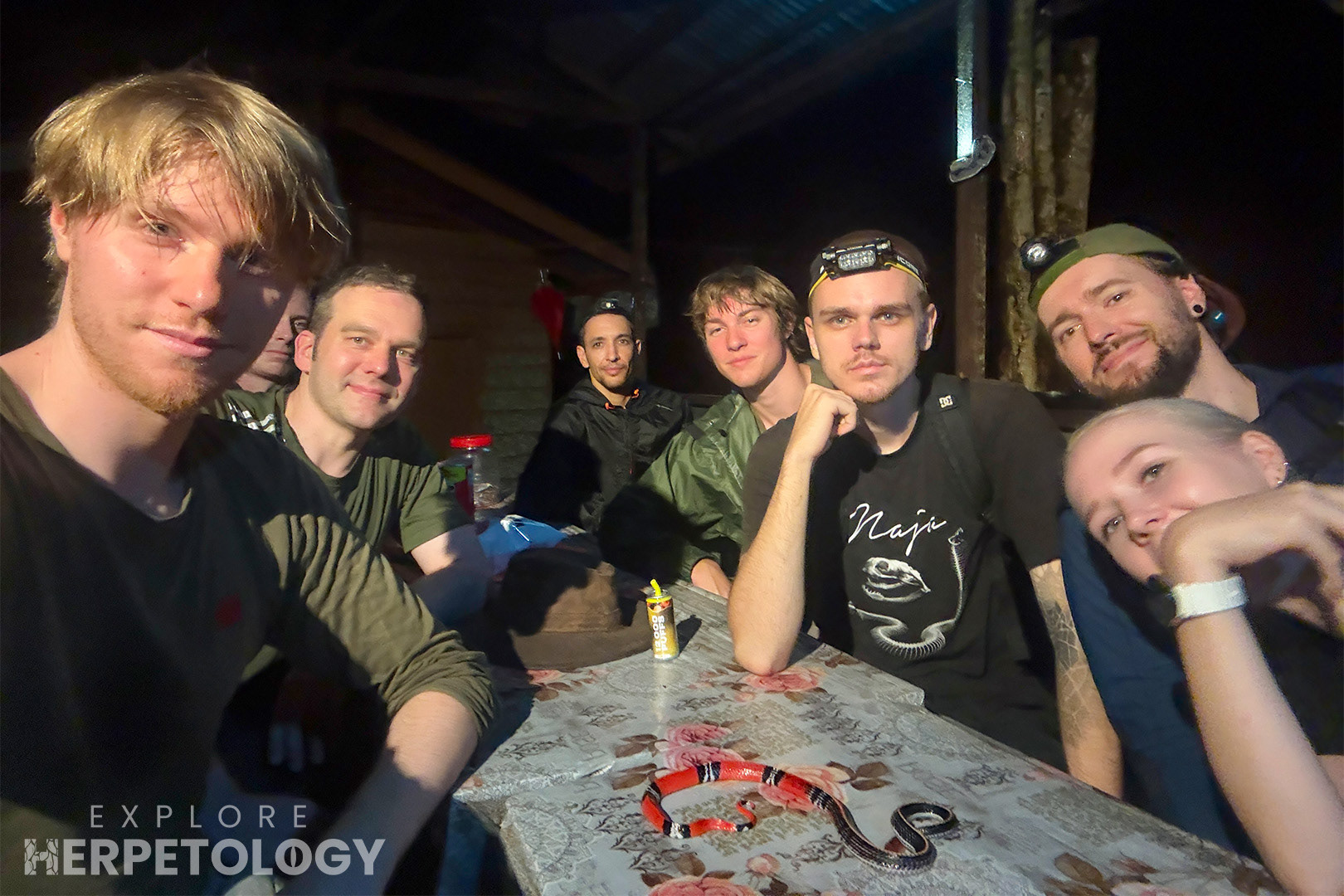
Juvenile krait with our March group
Day 8: Birthday Buff
The February Borneo expedition was mired by extremely heavy rain on 7 of the 9 nights of herping we had on this trip, making it very challenging to find high numbers of species per night. We had done great for vipers, with only the Bornean leaf nosed viper (Craspedocephalus borneensis) remaining by the penultimate night - which also happened to be the expedition leader Rupert's birthday.
What we call the "birthday buff" was already in effect when the heavy rains ended just before our night of herping in the lowlands began, sparing us getting soaked for the first time in a while. The buff kicked in even harder when a friend of ours who happened to be herping the same area on the same night found a Bornean leaf-nosed pit viper (Craspedocephalus borneensis). This was a lovely female with pinkish hues and a very defined "leaf nose".
We picked up a few more species, and were very happy with the turn out already. No rain and our final viper target! As we walked back to our hotel through disturbed habitat, Rupert spotted the tail of a jet black snake in the bushes and pulled out, to everyone's surprise, an adult Sumatran spitting cobra (Naja sumatrana)! Only moments after, thunder began rumbling and we just made it back to our hotel before the torrential rain began. This was our best night (diversity-wise) of this particular expedition, and so the belief in the "birthday buff" continues...
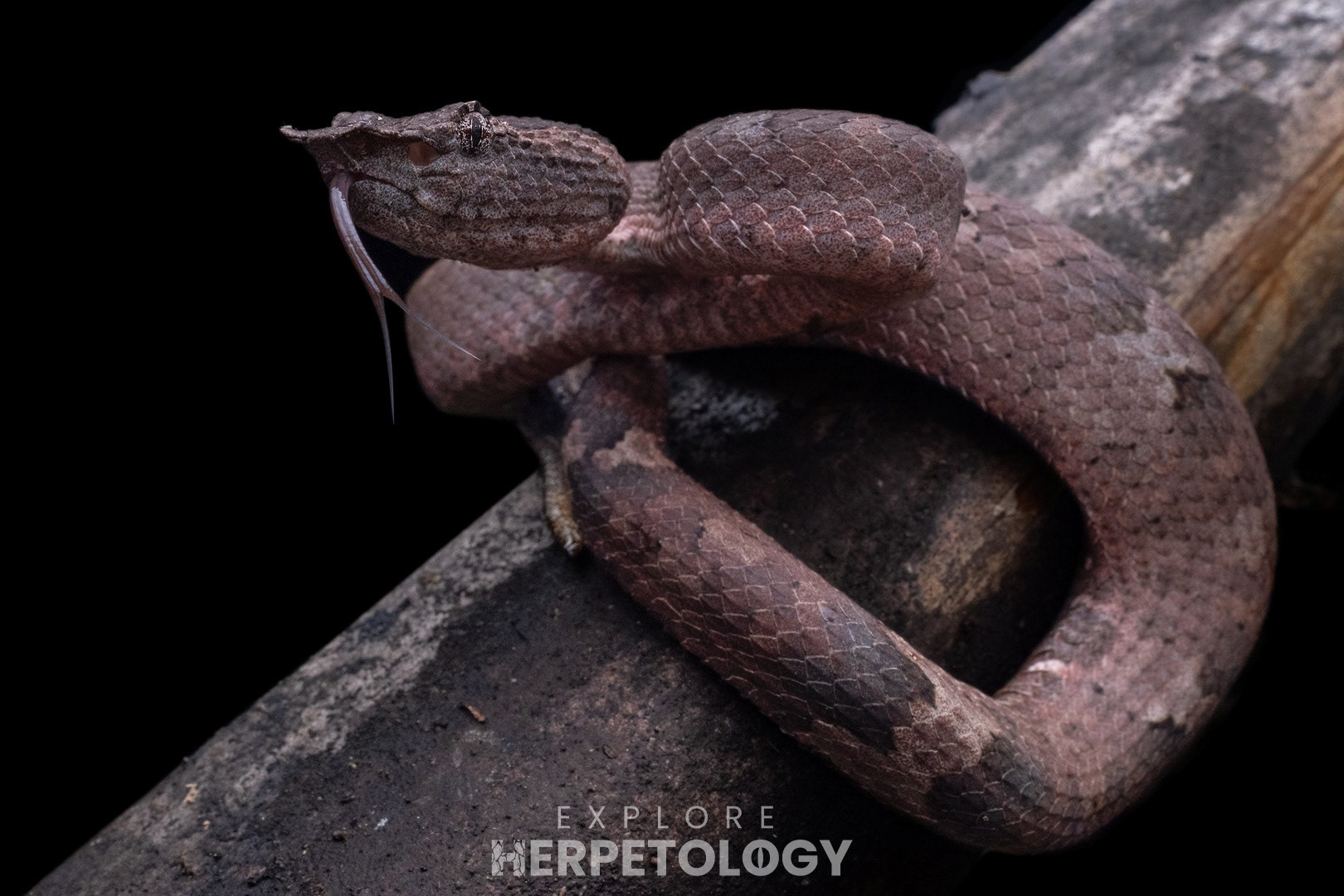
Craspedocephalus borneensis.
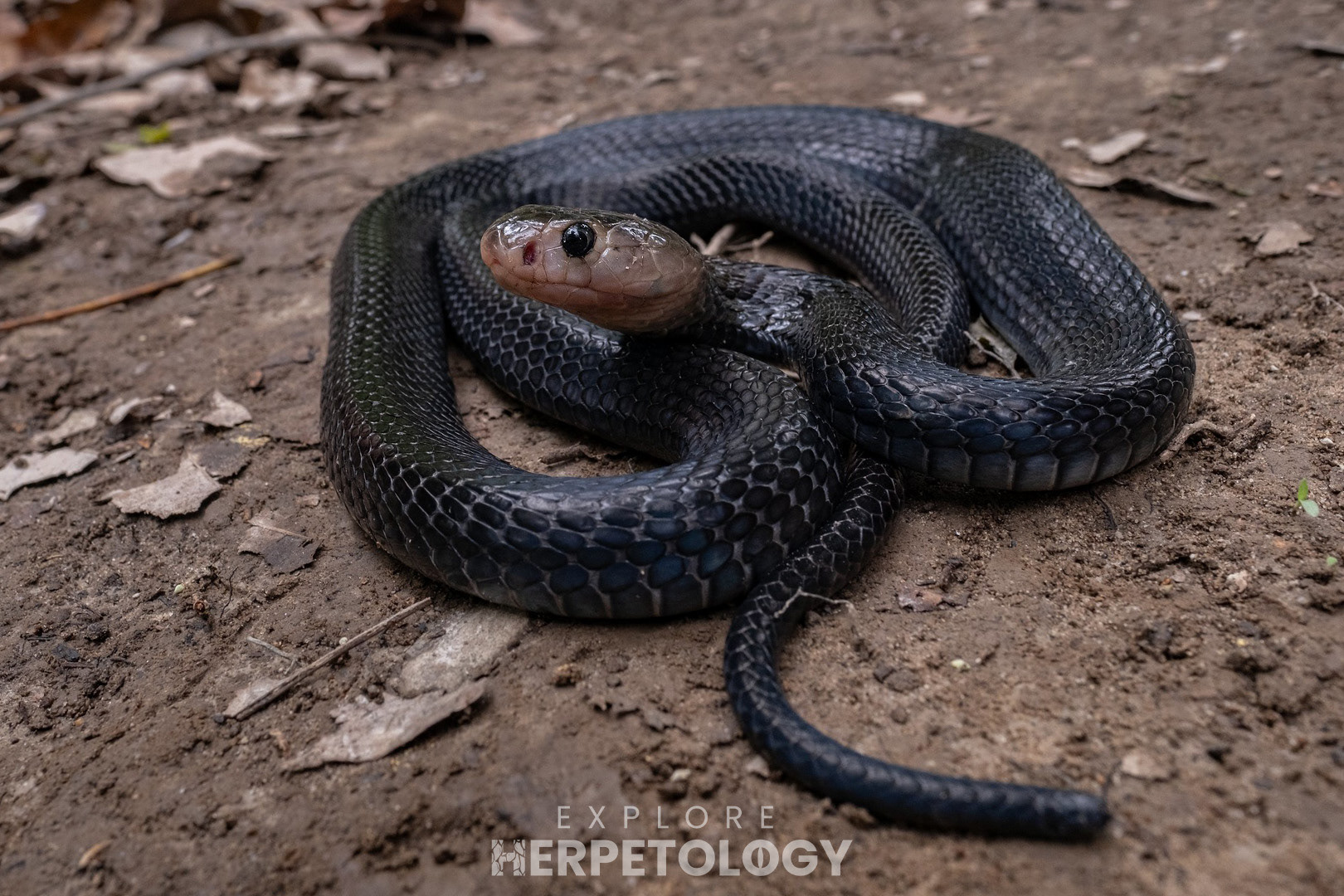
Naja sumatrana.
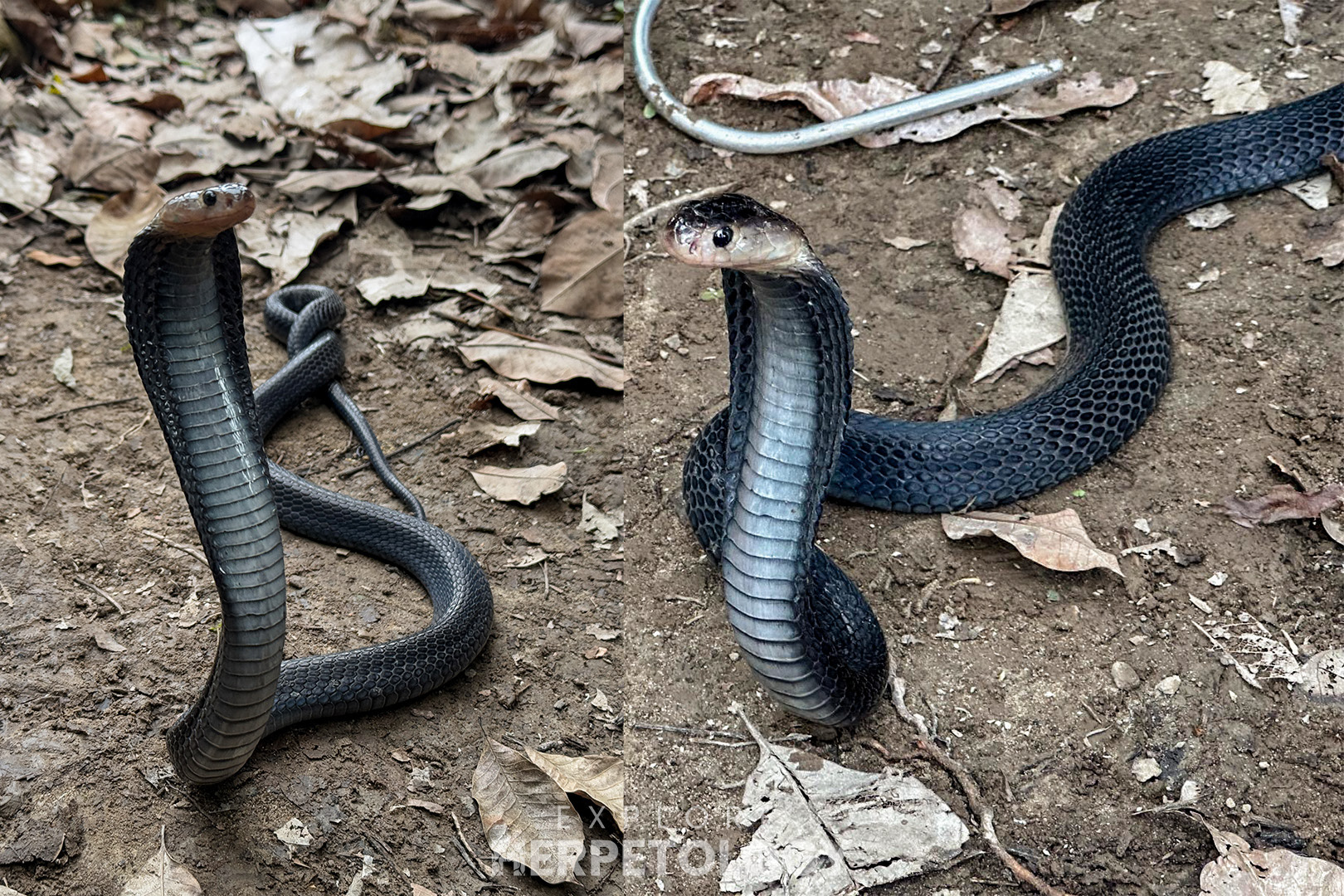
Defensive.
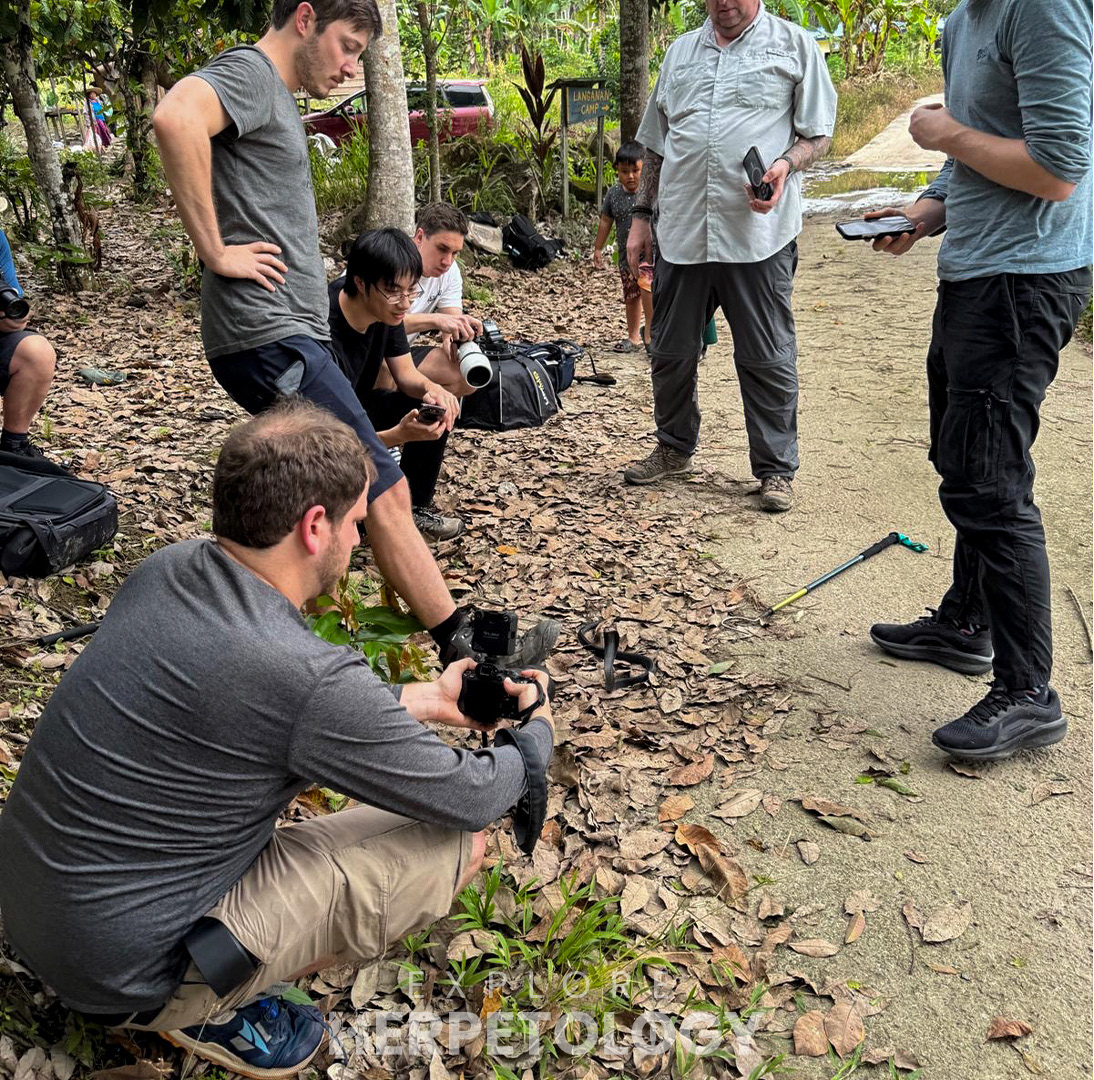
Cobra action!
Day 9: Expect the Unexpected
We jump forward in time to the March expedition for our ultimate final day moment of the expeditions. This was closely contested with a super diverse final day on the December trip, where we found a leaf-nosed pit viper, a rare Oligodon everetti and several other good snakes. However, this story is just too crazy not to include, and we have not featured any daytime snakes yet.
After two sensational Kinabalu krait encounters, we were taking it easy during the daytime and saving energy to go hard on our final night. Rupert was relaxing in his room, until he got up to refill his water from the kitchen area. Upon opening the door of his room, he was immediately shocked by a snake sitting directly outside the front door. There are many species this could have been, but it just happened to be an eight-striped kukri snake (Oligodon octolineatus). This kukri had been one of the ExHerp team's biggest 'white whale' species for so long, and had risen to being one of our biggest targets every time we visit Borneo. It was absolutely crazy that the first encounter with this species happened without even looking for it (or any snake at all).
We went on to have a good final night too, with our first ever juvenile twin-barred flying snake (Chrysopelea pelias) and 5 species of snake total.
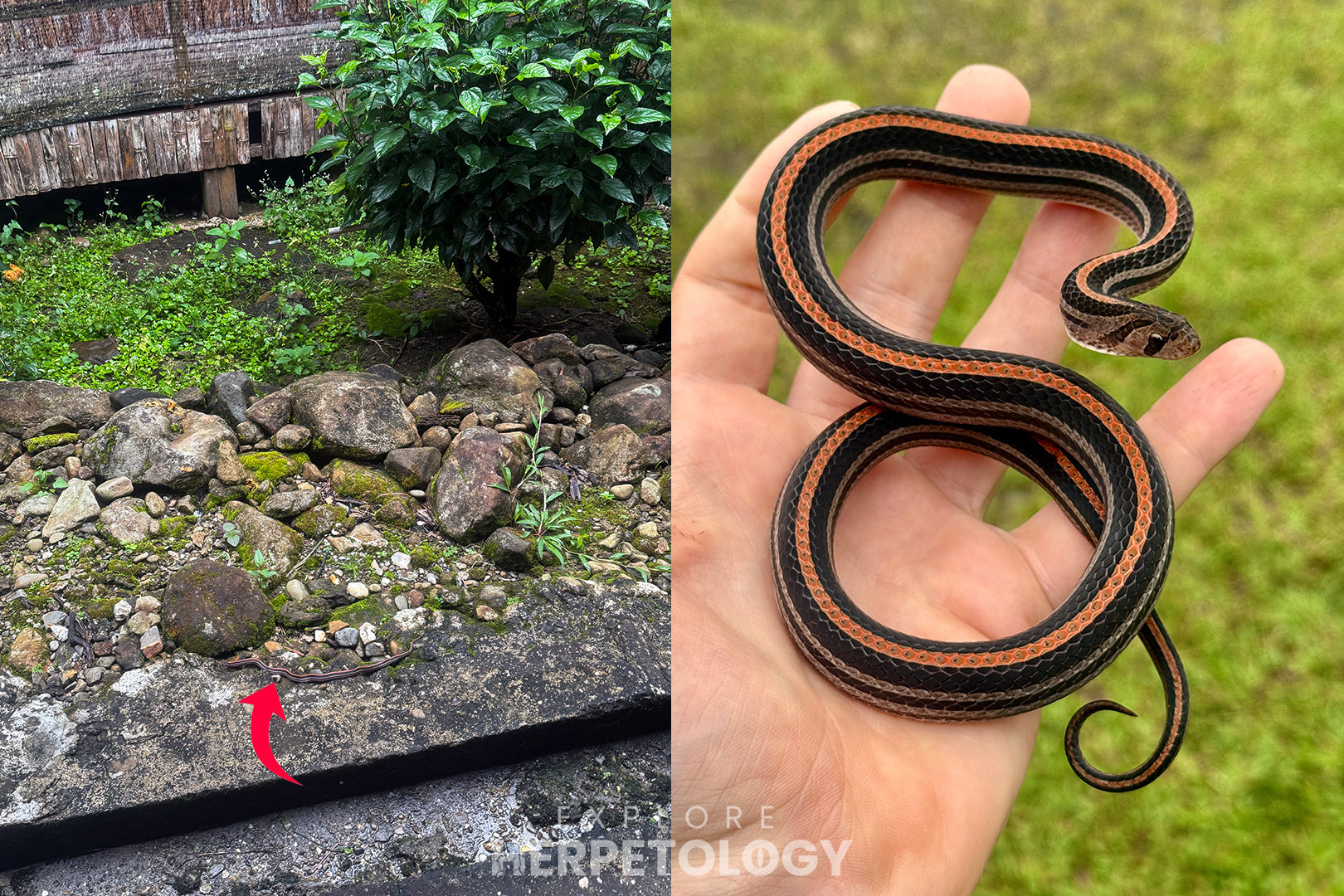
In-situ & in-hand.

Oligodon octolineatus.
The fact that we had a memorable moment to include for each day in chronological order is a testament to the success of these trips. Indeed, we found all 6 viper species on both December and February's herping trips, only missing Craspedocephalus borneensis on the March expedition (which beat out both of the previous trips on species count). Indeed, our team have immense experience in these areas and have a deep understanding of the ecology of all the major targets, completely dedicated to making the trips as successful and immersive as possible. Featured below are a few animals and encounters which did not make it into this report.
Interested in a herping trip to Borneo? Browse our expeditions page to check for available Borneo spaces or contact us to organise a private tour at your own convenience.
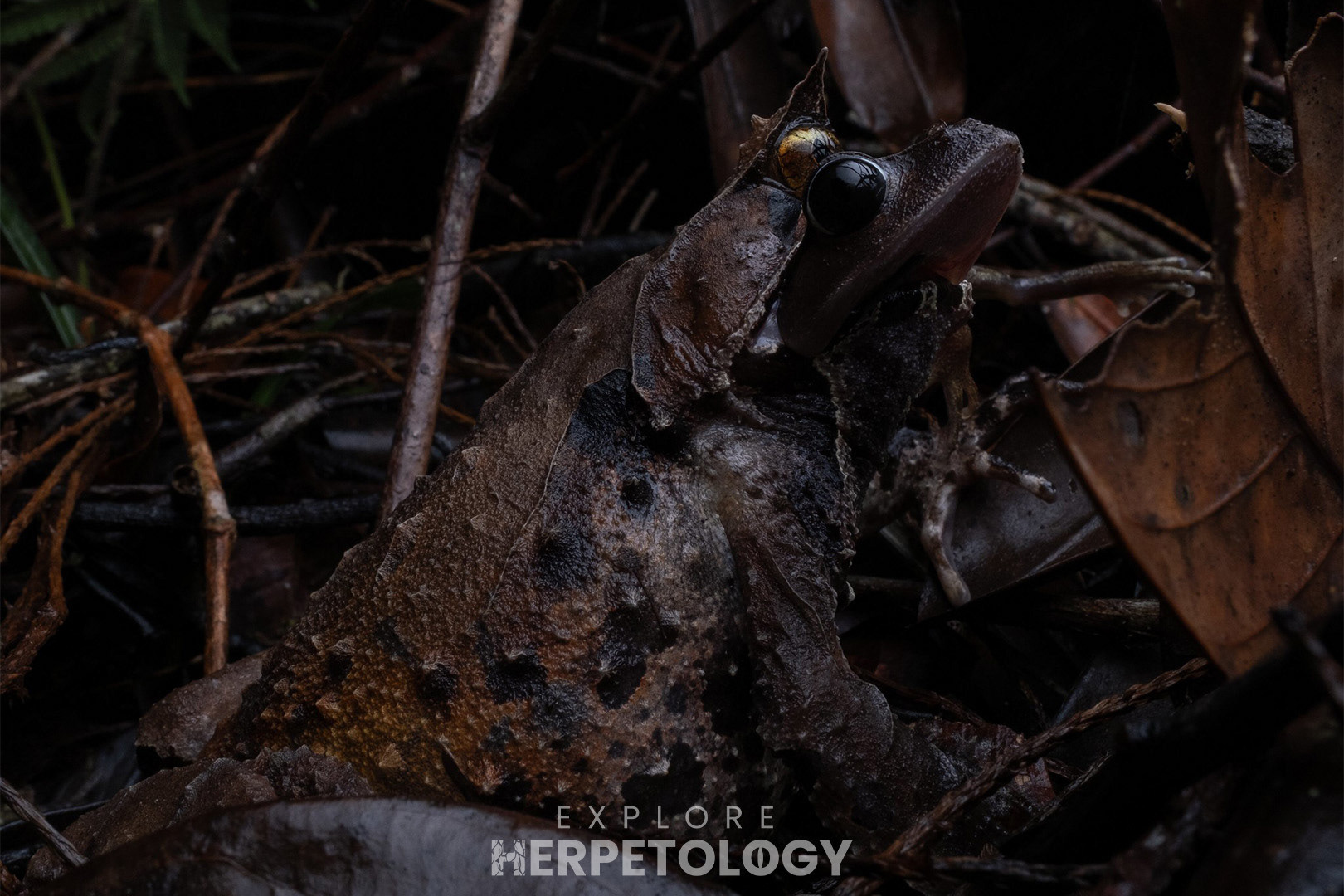
Pelobatrachus kobyashii predating Leptobrachium monticola

Juvenile Python breitensteini.

Boiga dendrophila consuming carrion rat.

Naja sumatrana juvenile.

Oligodon everetti.

Gekko rhacophorus
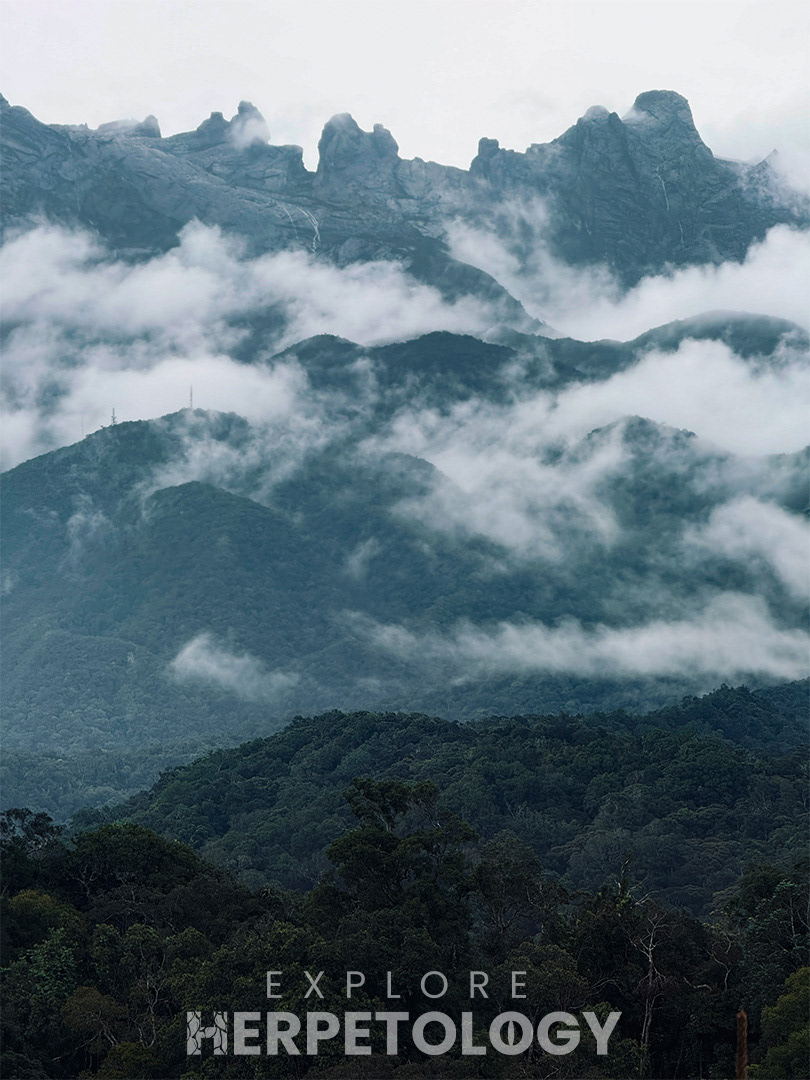
Mount Kinabalu 1500 - >4000 meters.
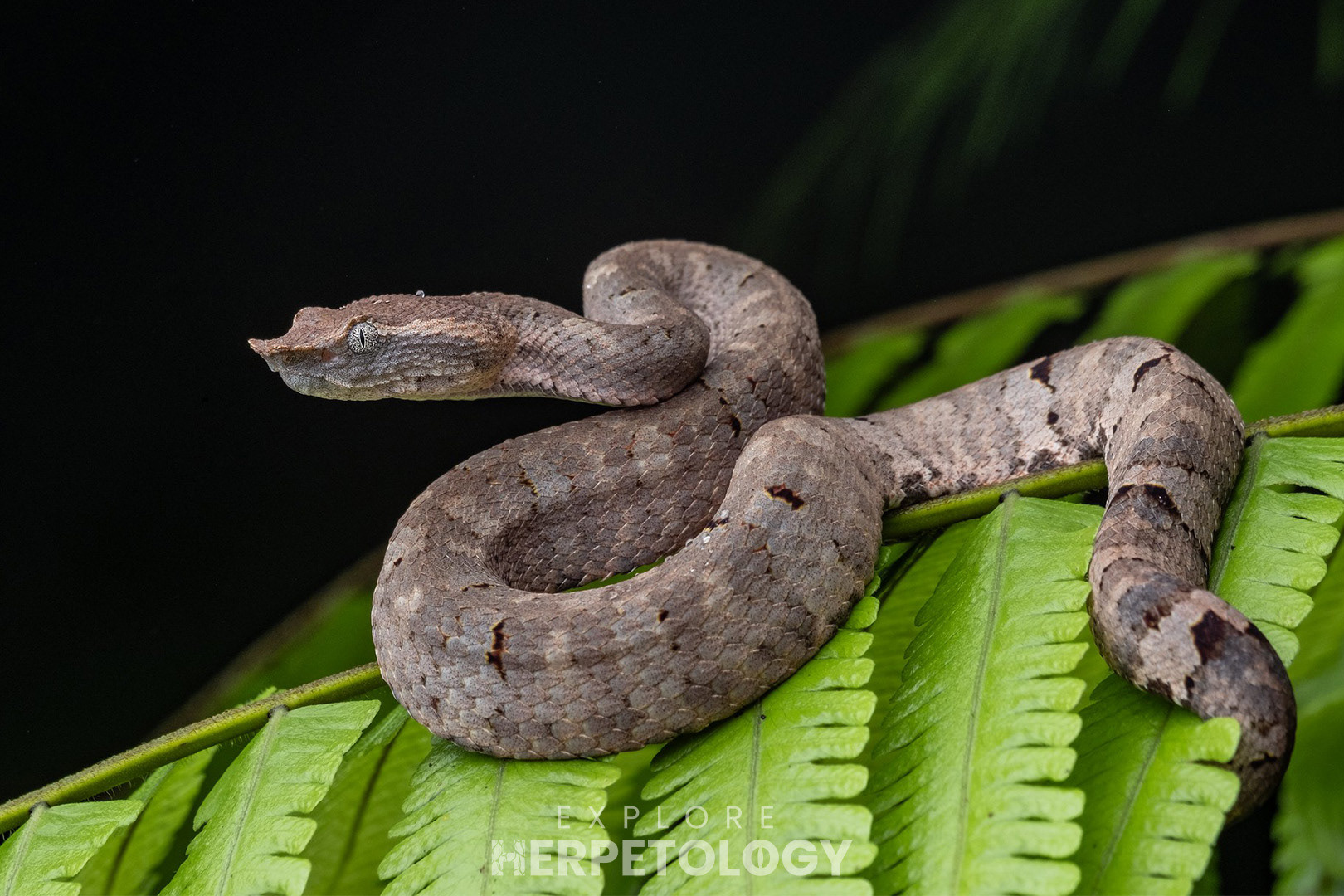
Craspedocephalus borneensis.
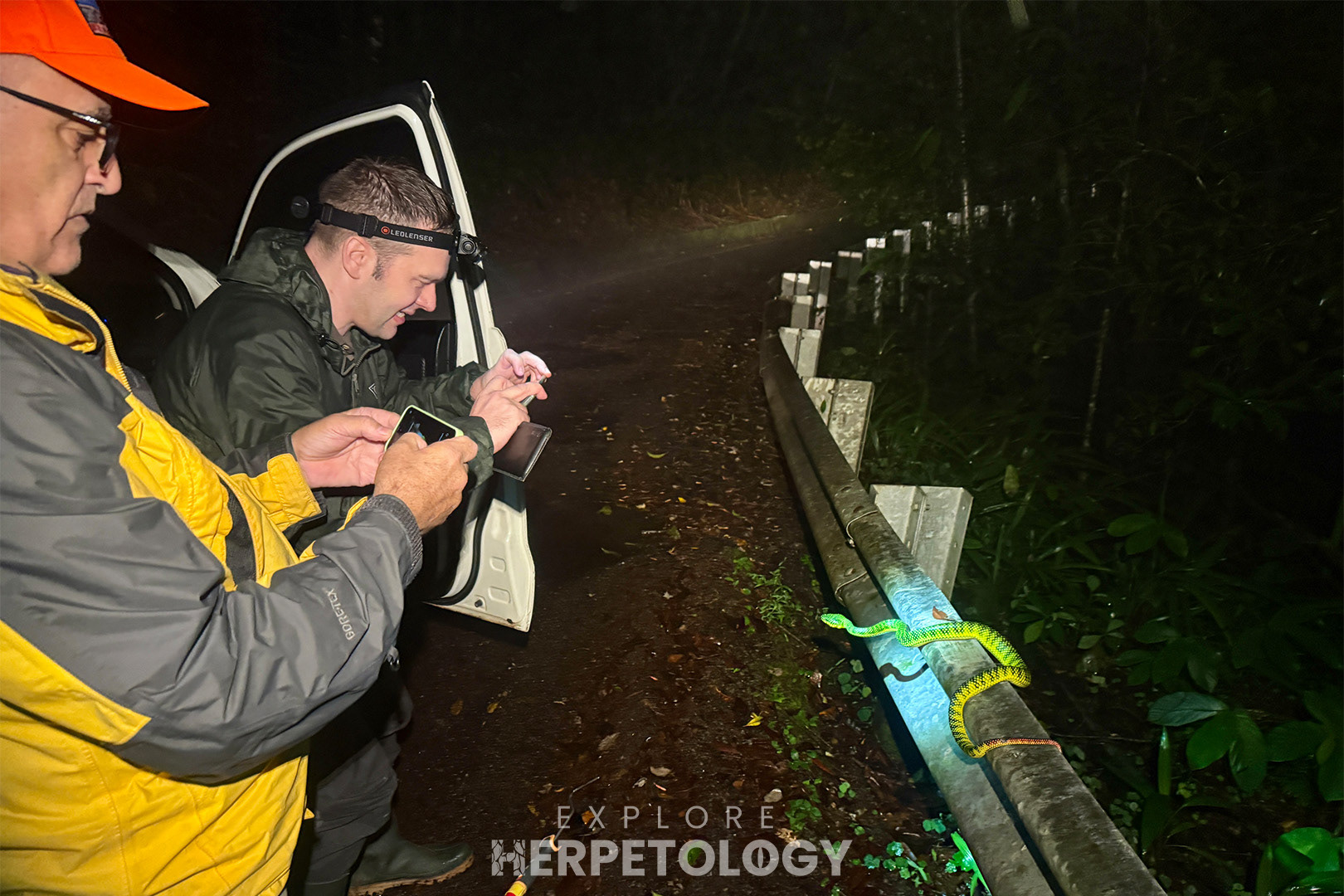
In-situ Malcolm's pit viper.

The largest Malcolm's we ever saw.
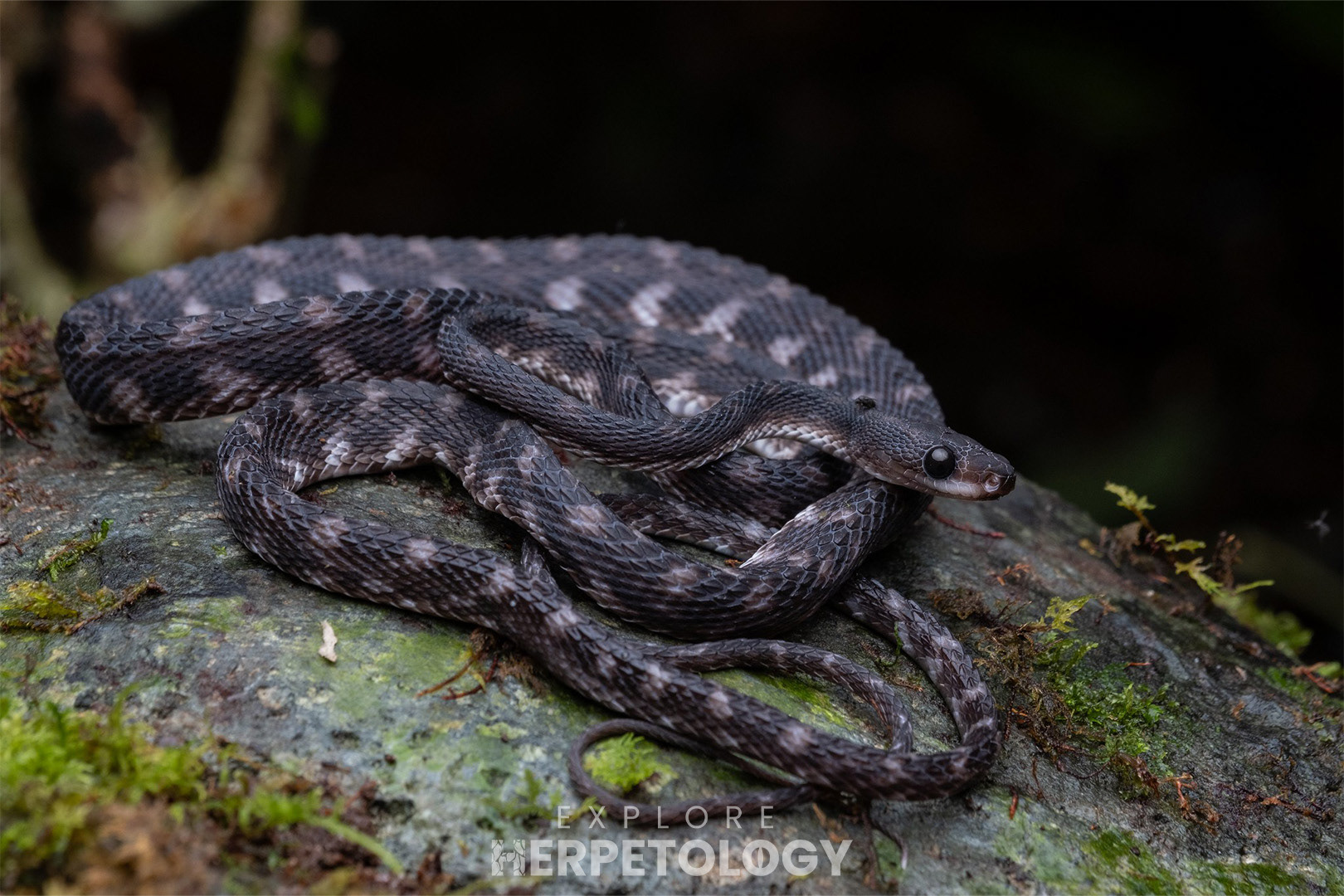
Paraxenodermus borneensis
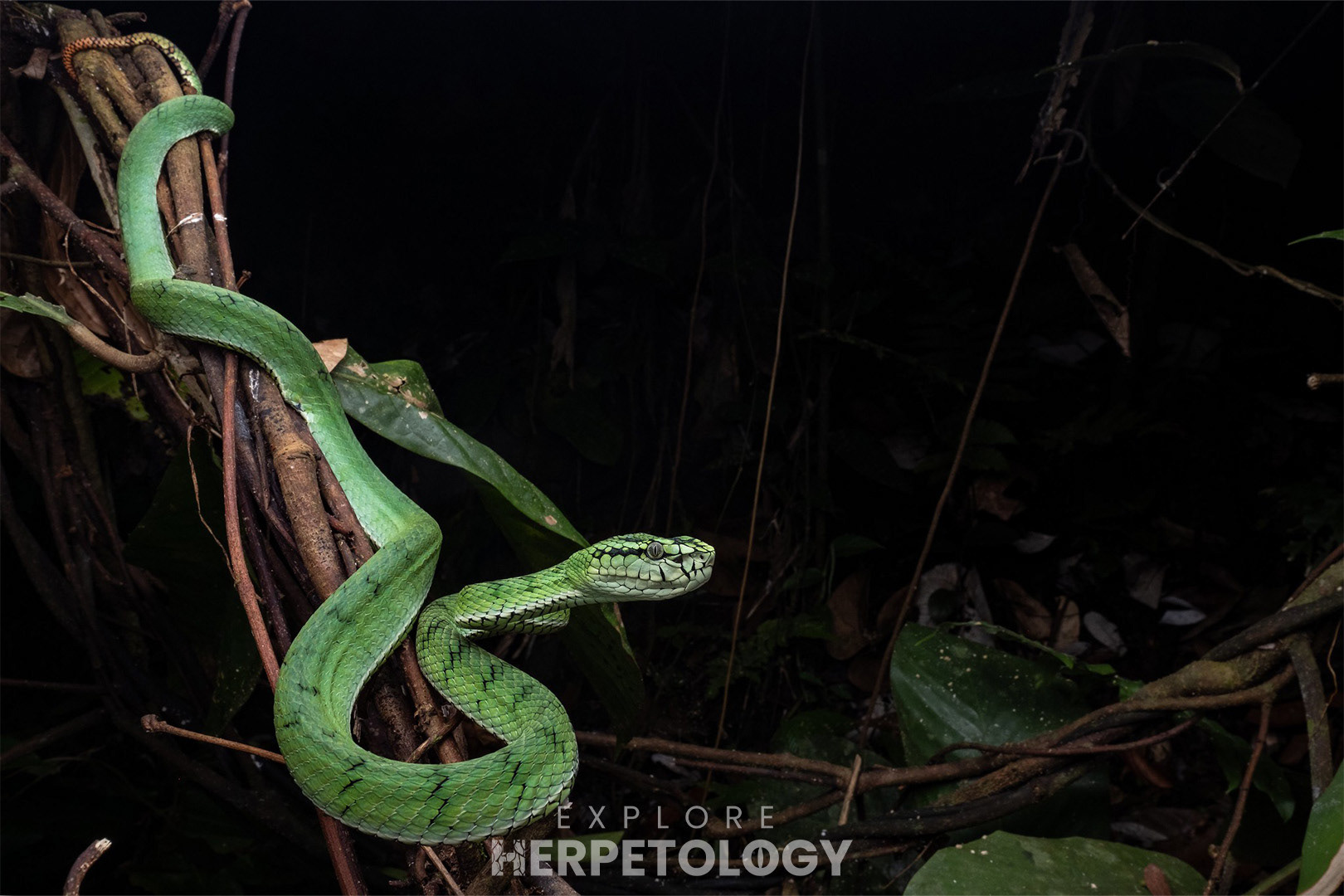
Sumatran pit viper female.
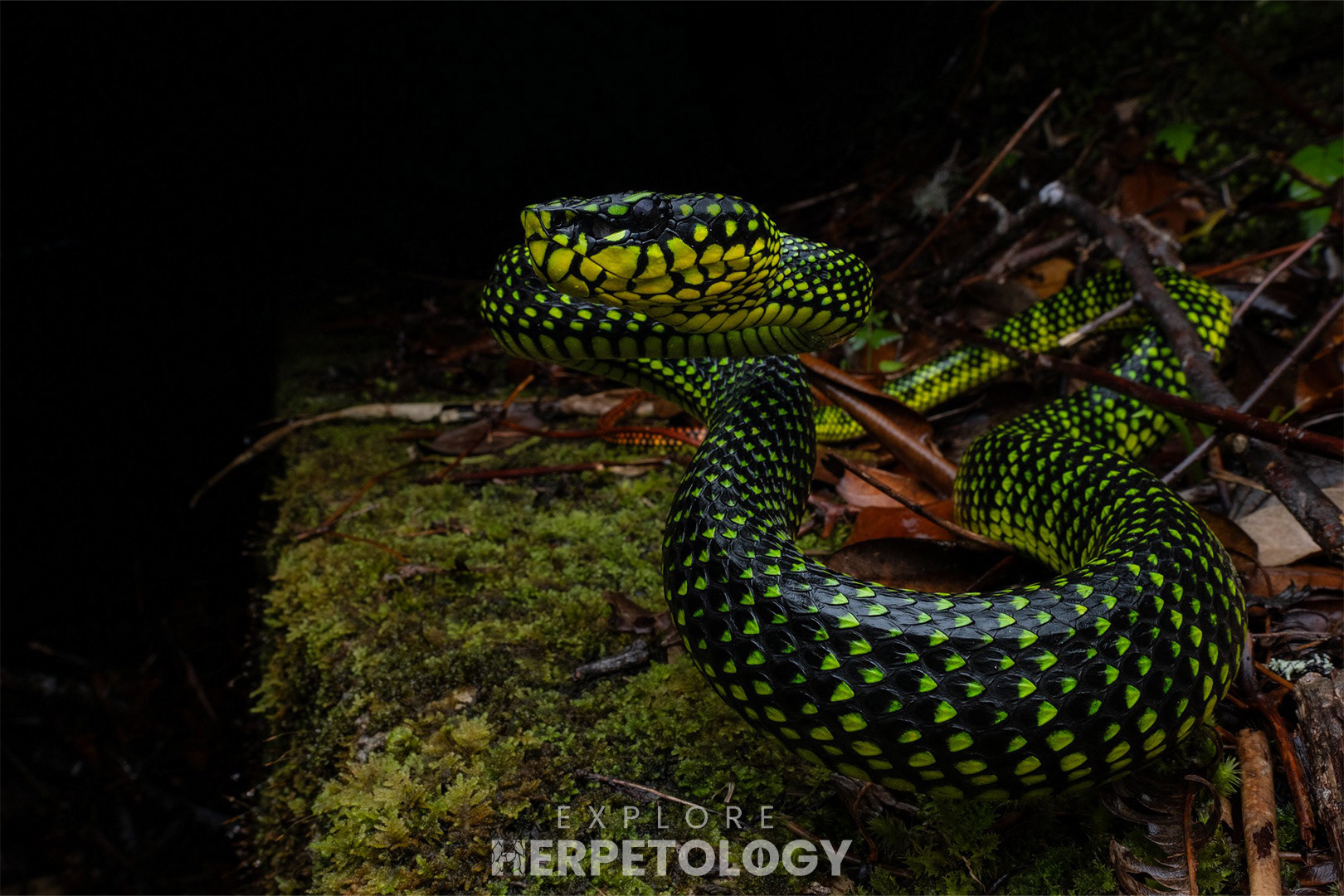
Male Malcolm's pit viper.
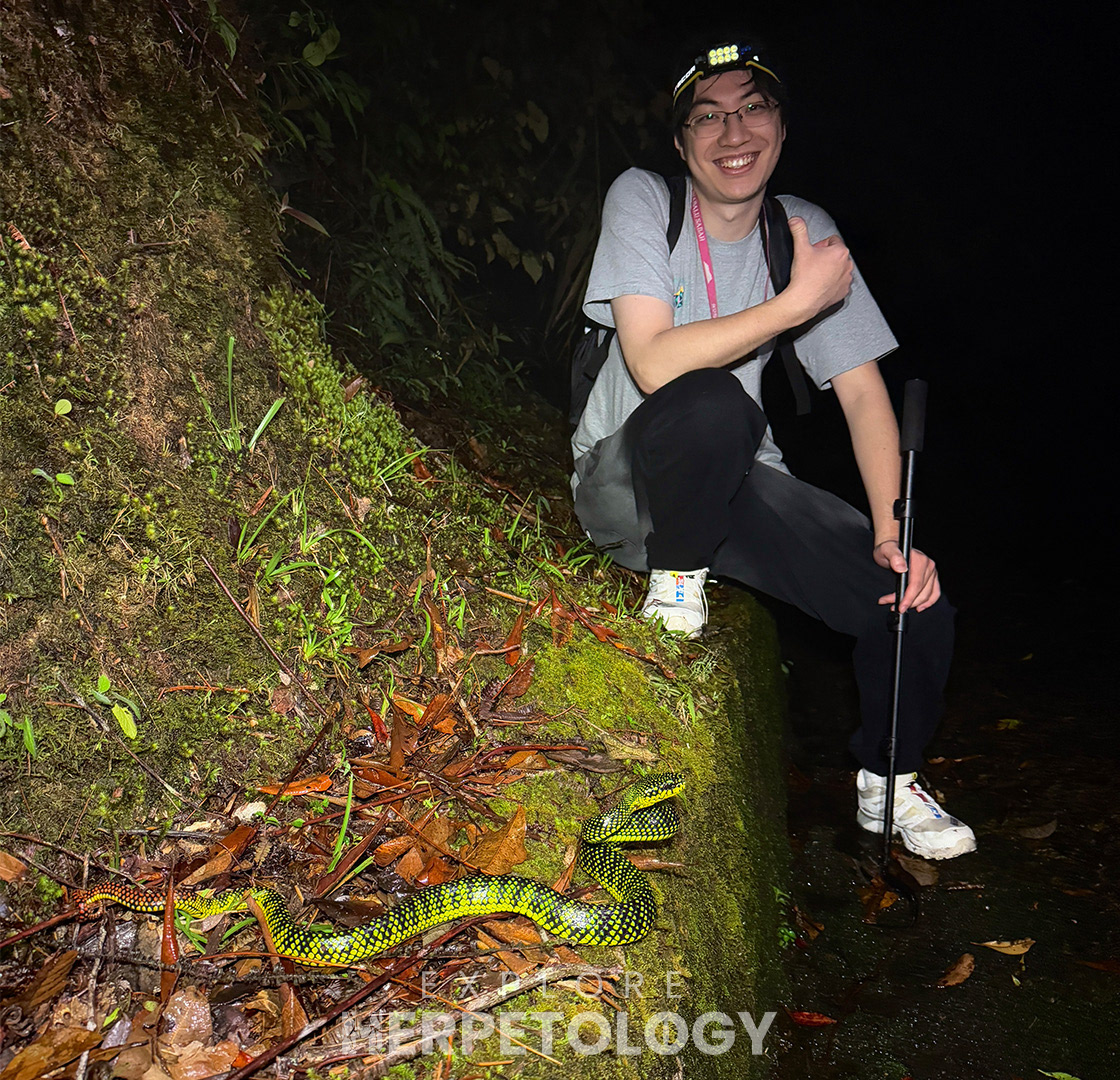
Malcolm's.



